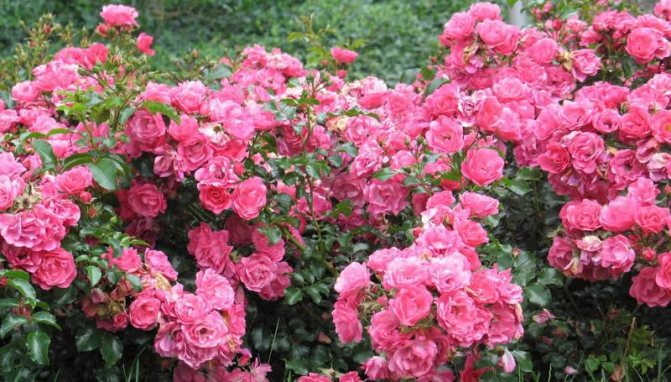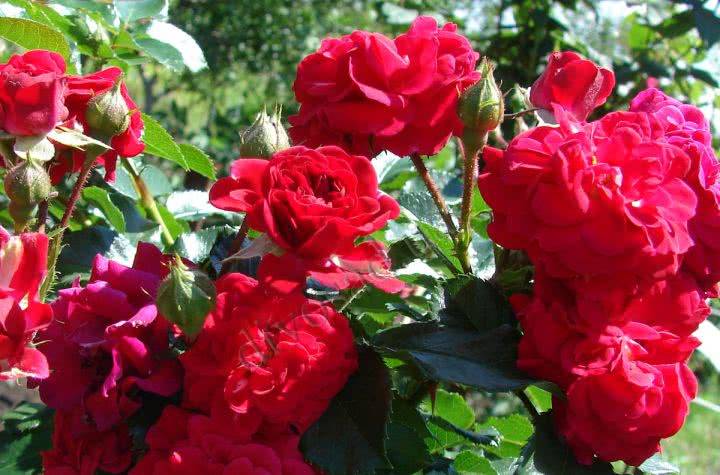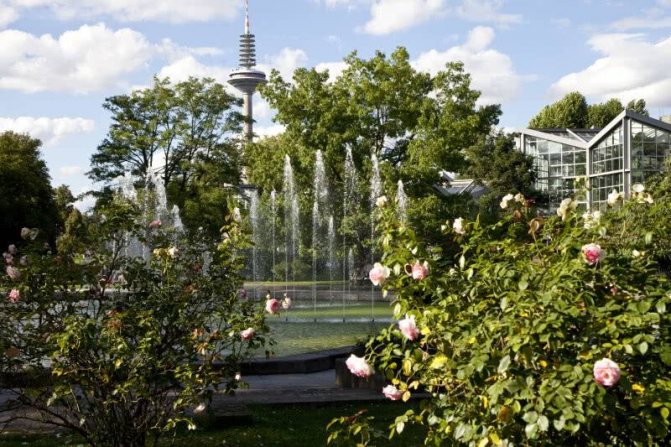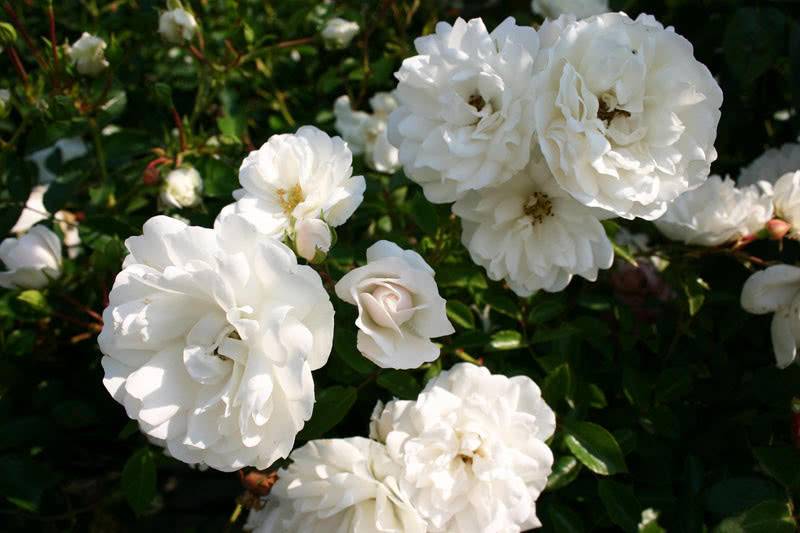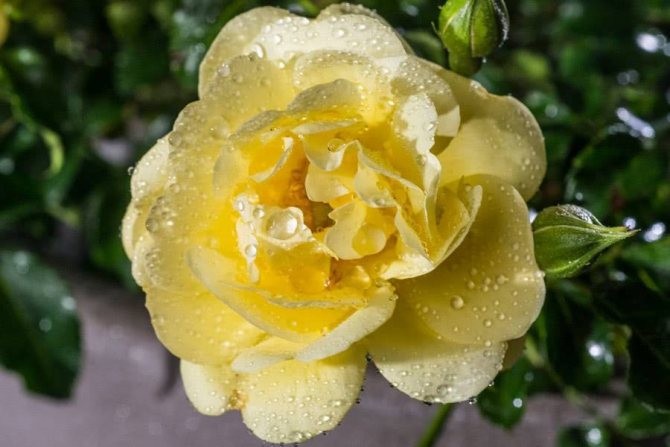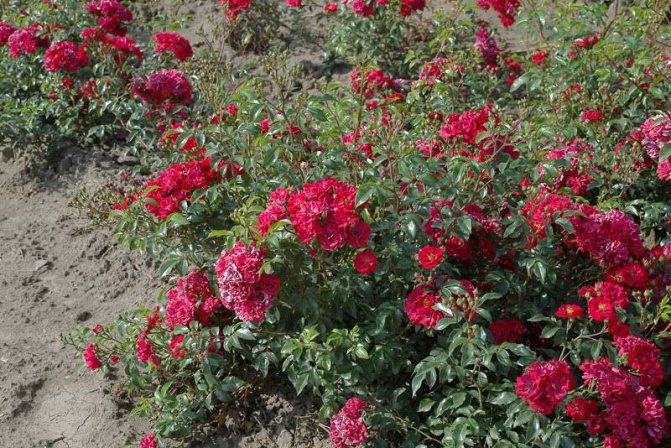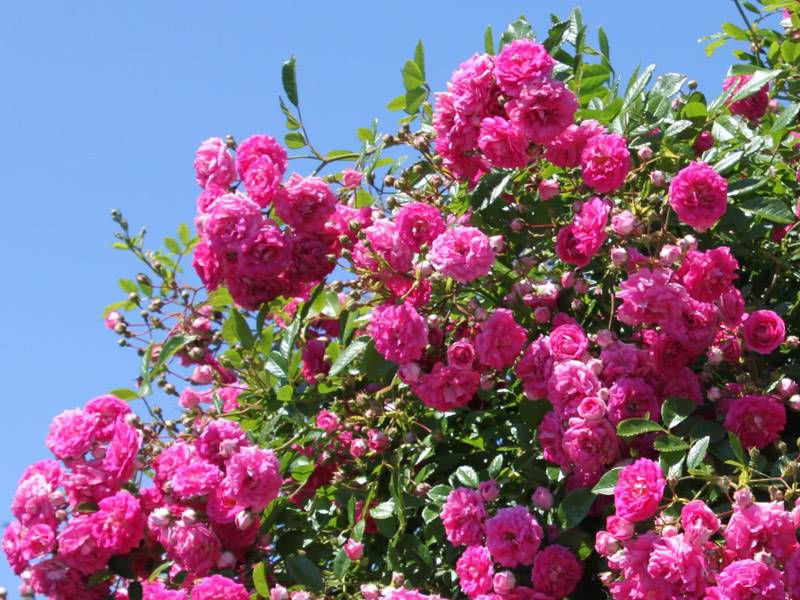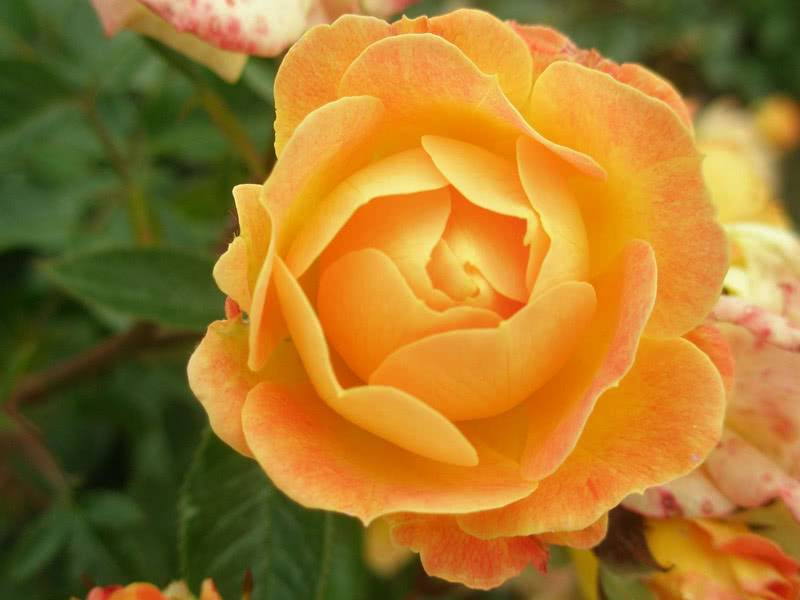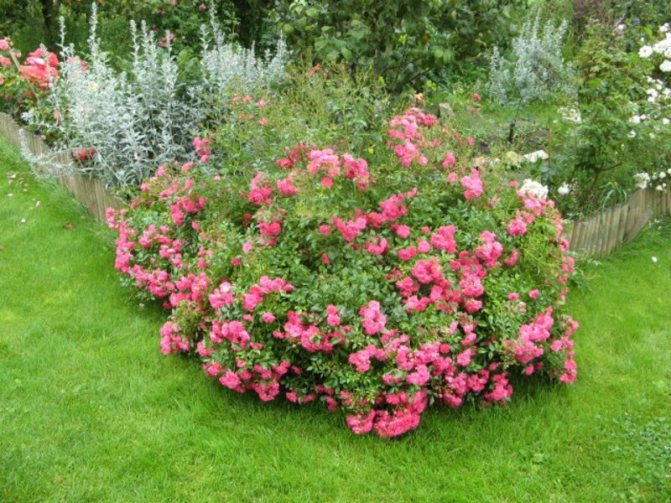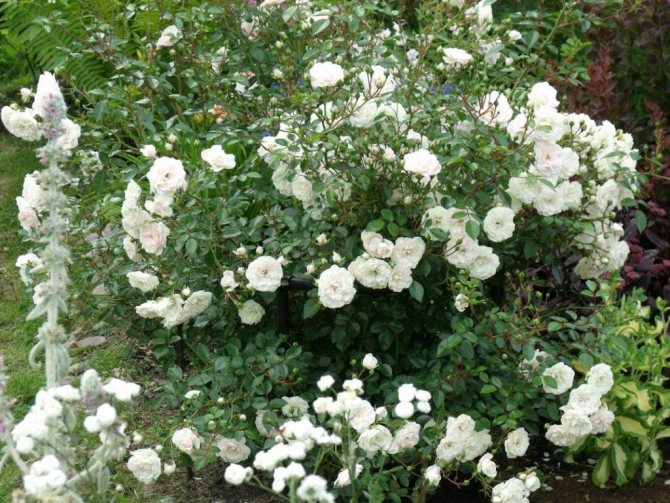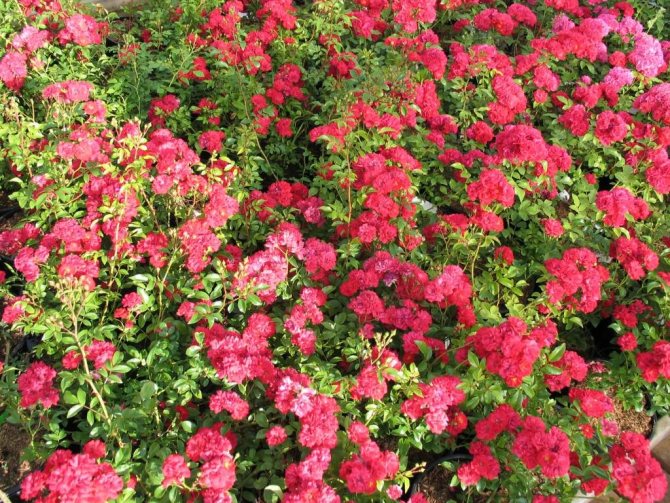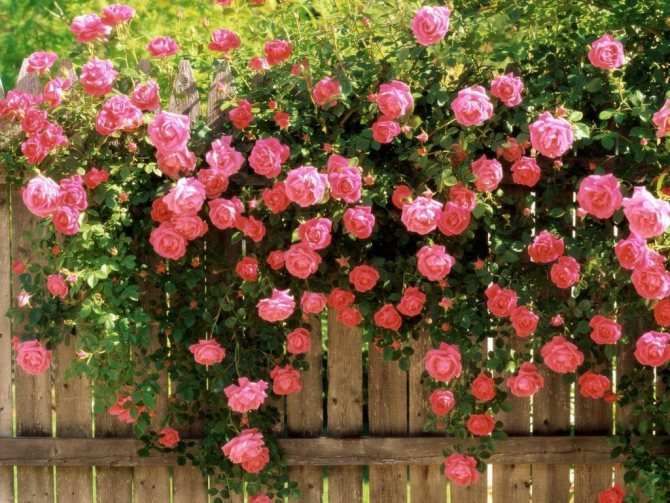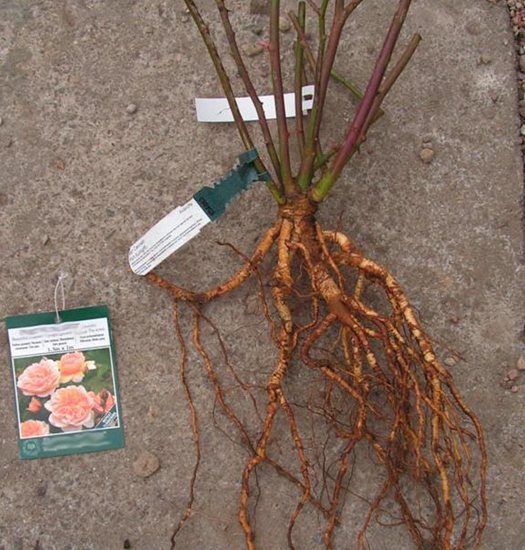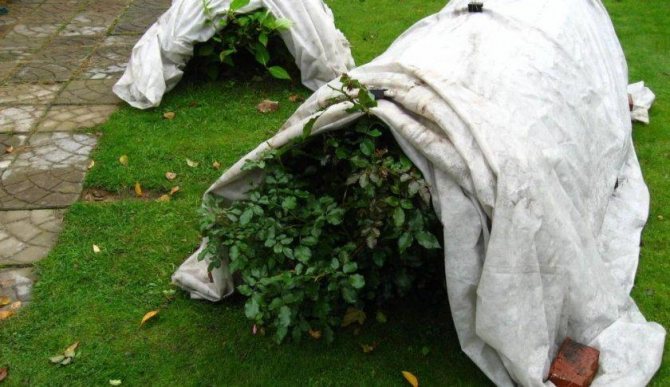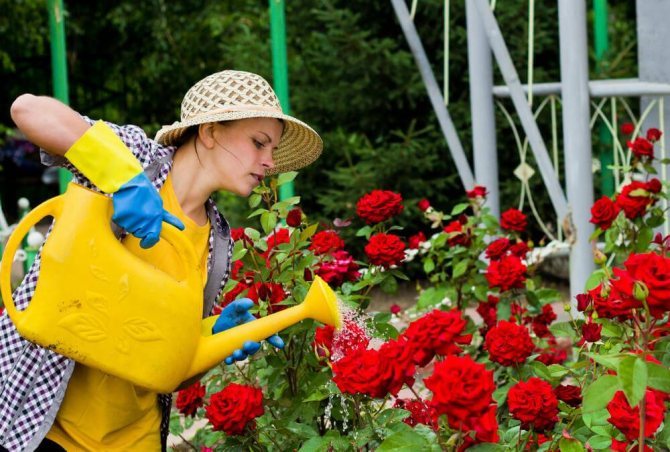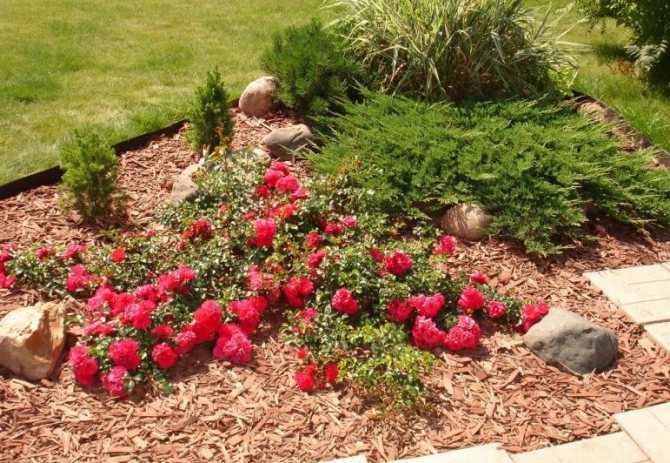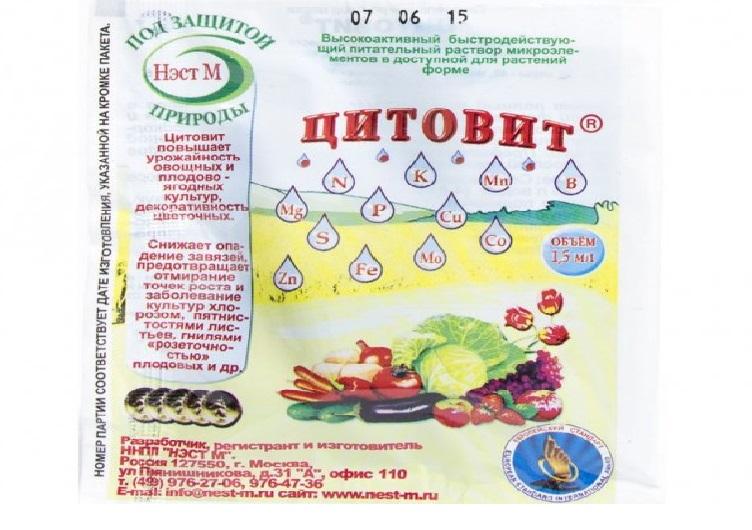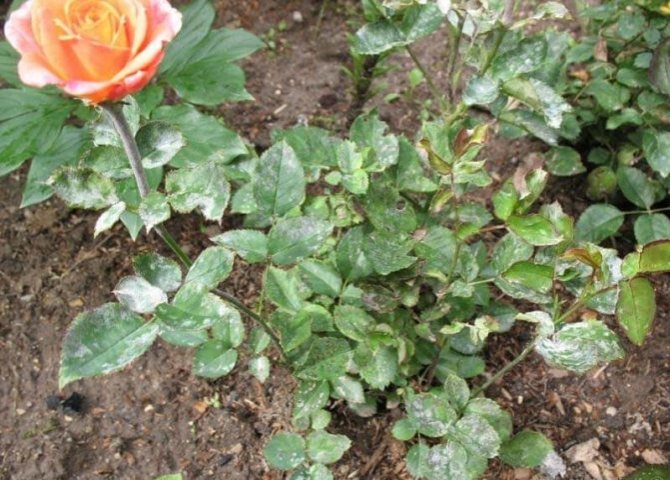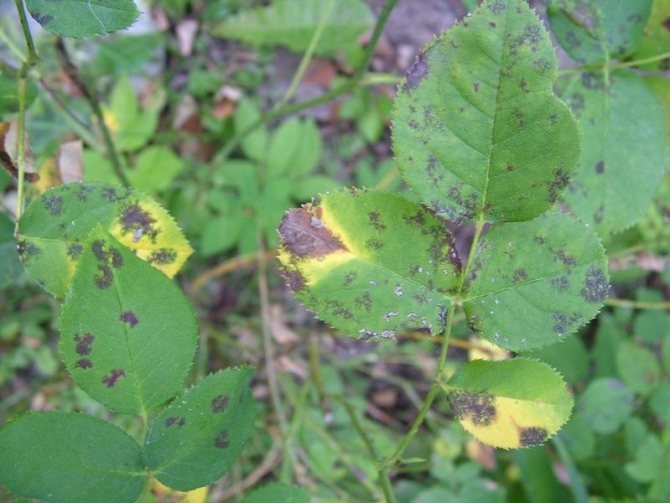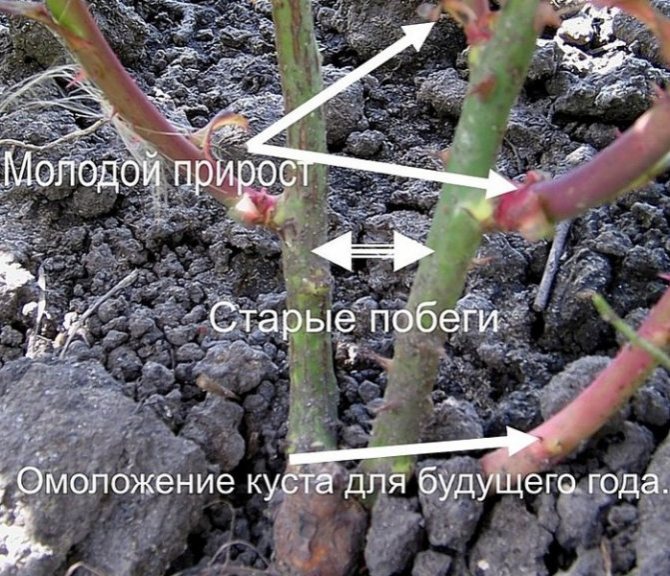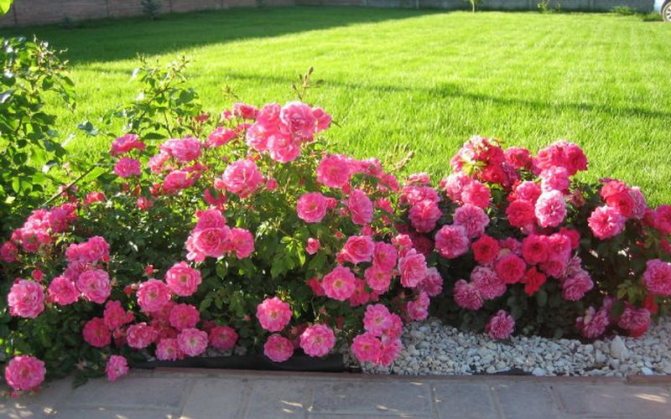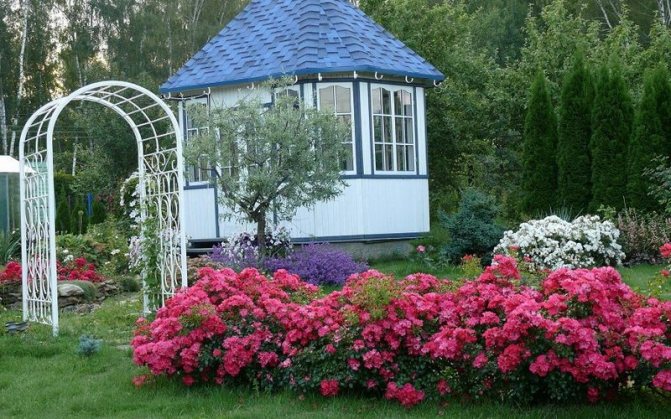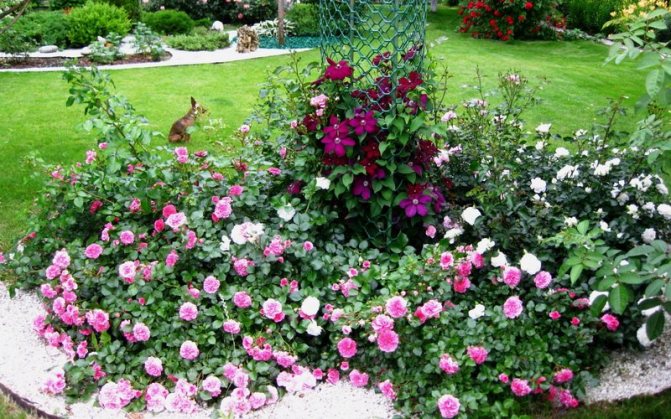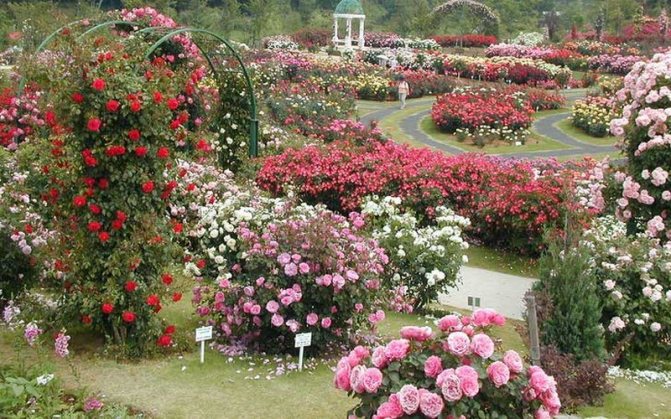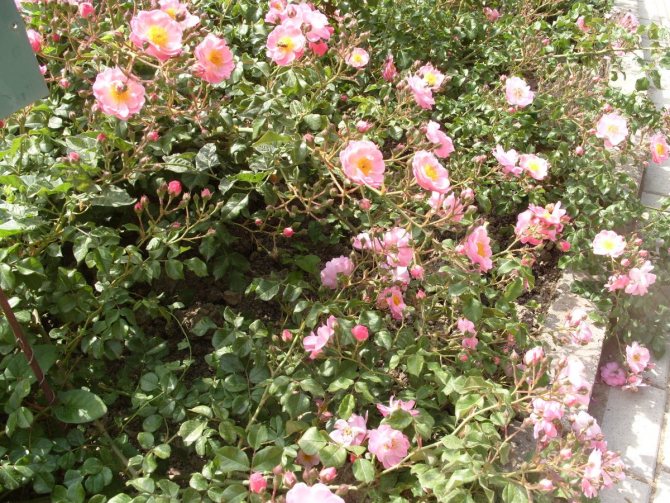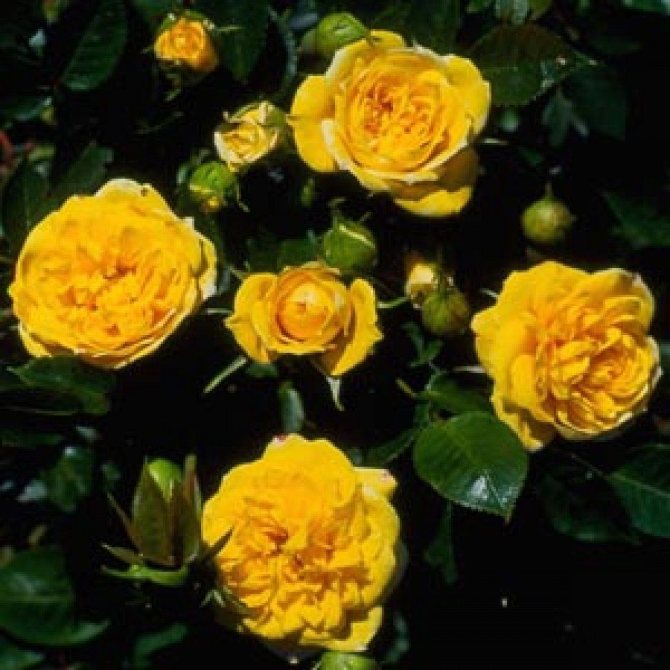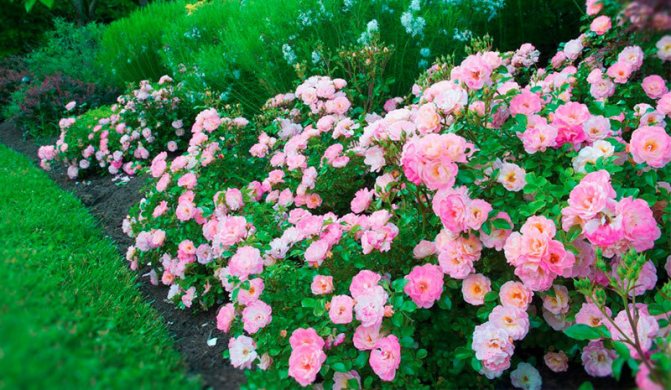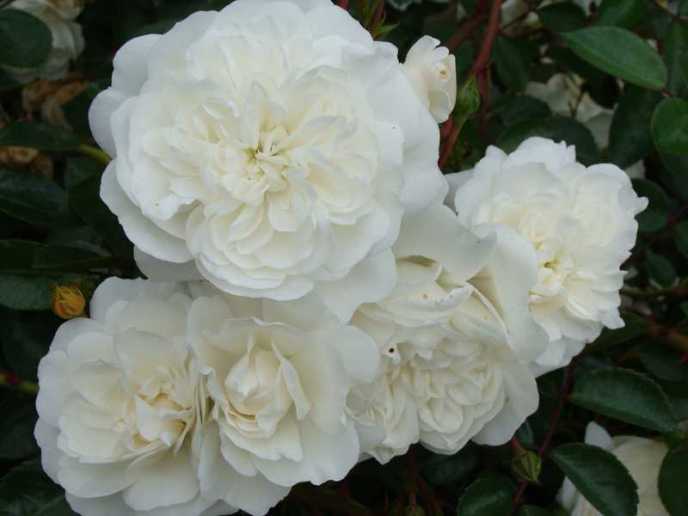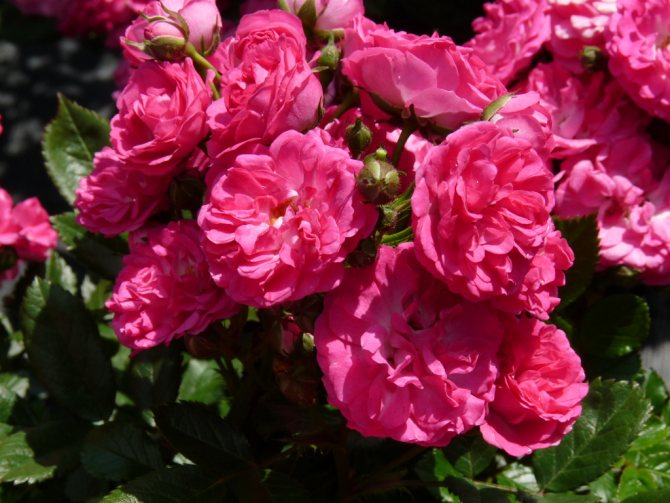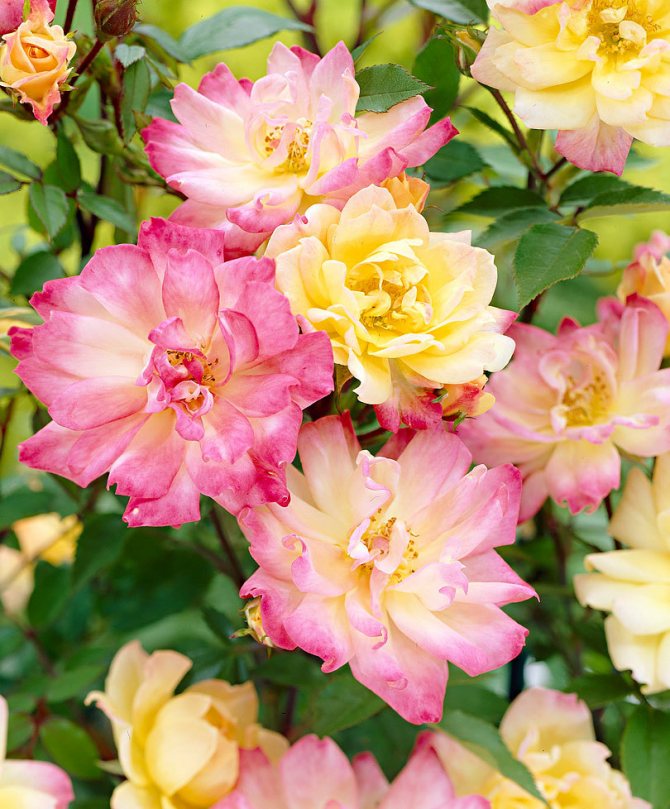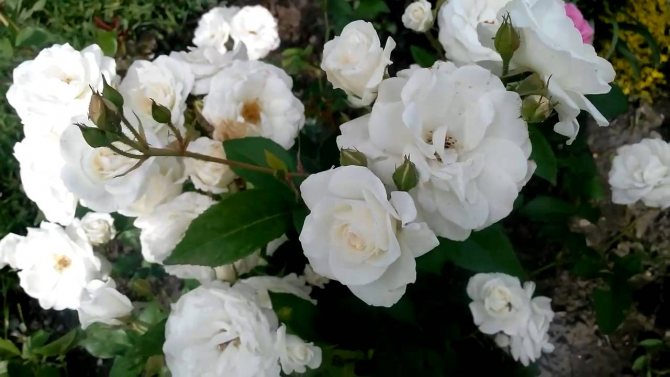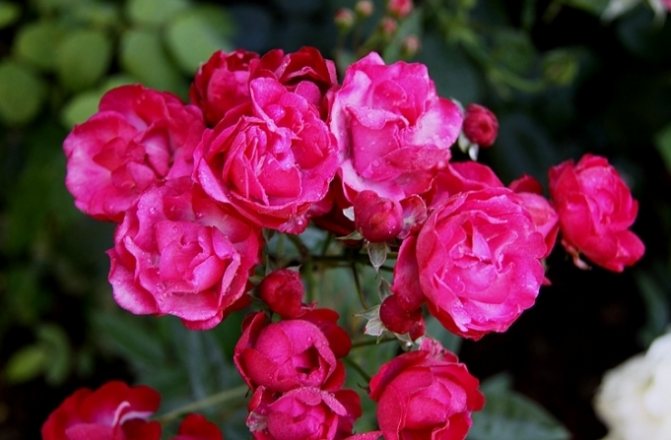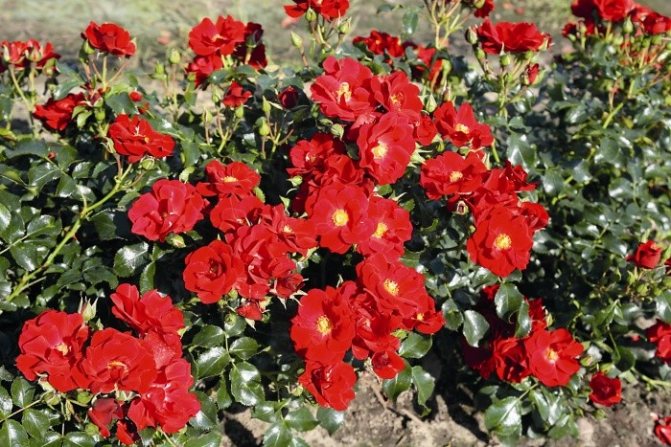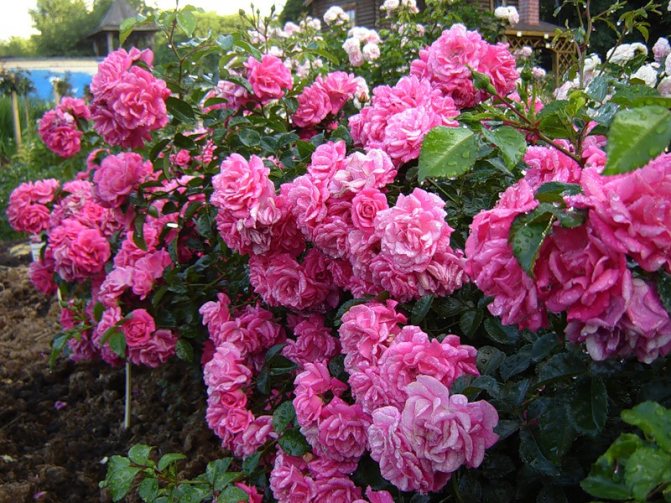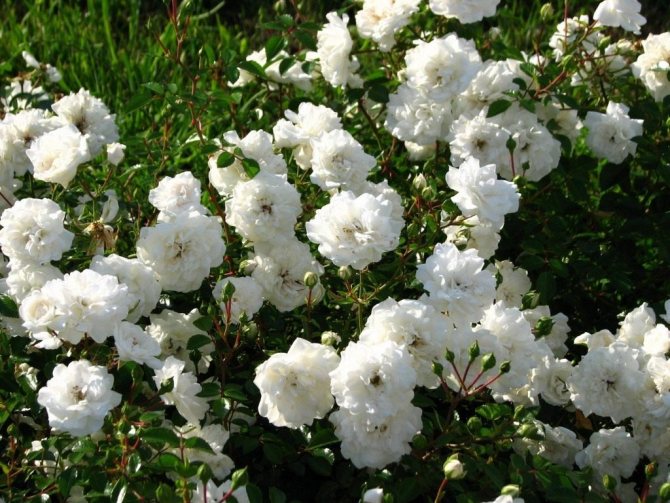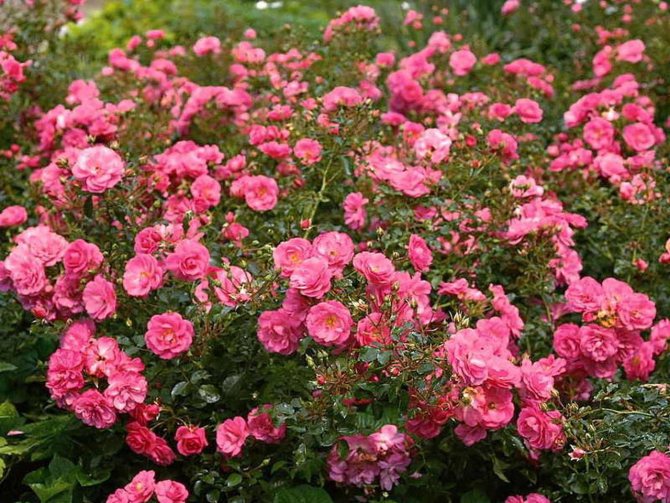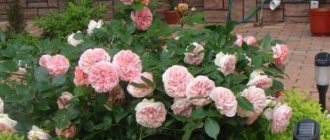Ground cover roses, blooming all summer, occupy a special place in the ranking of popular varieties. They give the site an original decor, fill empty and unsightly places, create a bright range of colors, and protect the slopes from washing out. There are a lot of modern varieties. It is simply impossible to remember everything. Therefore, gardeners choose the most attractive and unpretentious.
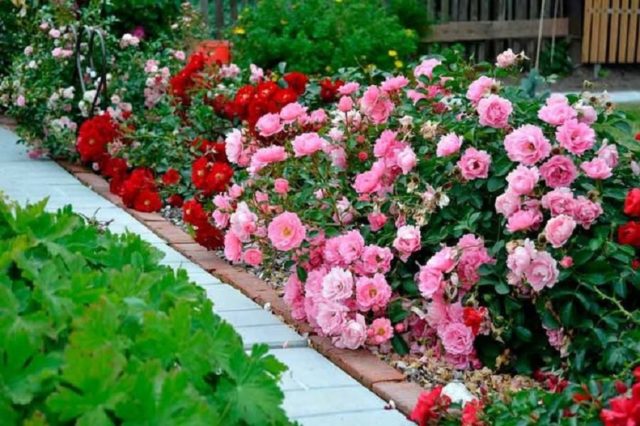
Ground cover roses: origin and types
The progenitor of ground cover roses was the Japanese or wrinkled rose (Rosa rugosa), which grows in eastern Asia. She became the form on the basis of which creeping hybrids began to appear. In the course of breeding, the Rosa wichurana variety was used. At the beginning of the 20th century, Max Graf and Fairy were bred, which can rightfully be considered a ground cover. The process of breeding new varieties and hybrids continues now.
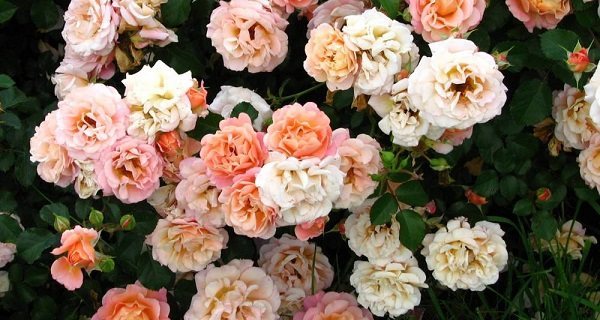

Description and features of the variety
Groundcover roses are a new group of Asian origin with the following characteristics:
- Length up to 4 m;
- Large sizes of plant carpet from creeping shoots;
- The possibility of re-flowering;
- High frost resistance;
- High resistance to various diseases.
The group of plants was bred on the basis of Vihur's Rosehip and Wrinkled Rosehip. Carpet roses have creeping or drooping stems that grow well in width. The shrubs do not exceed one and a half meters in height. If you plant several bushes of culture next to each other, then you can achieve a dense carpet that will occupy a vast area of the site. Flowers are low-growing shrubs that can vary in the type and growth of the shoots, as well as in the color, shape and size of the flowers.
What kind of “companions” are suitable for cohabitation?
When choosing partners for ground cover roses, it is necessary to take into account the compatibility of the color range, the flowering period, as well as the shape, texture and color of the foliage of the plants. It is also worth paying attention to the conditions for growing companions for the aristocrat of the garden landscape - they should be light and heat-loving, similar to roses. Beautiful ensembles with carpet roses of any shades and varieties are created by lavender, daylily, geranium. The queen of the garden looks harmoniously with a variety of herbs and cereals - rosemary, fennel, thyme, fescue, sage, garlic, onions. Creeping roses are perfectly combined with primroses, viols, geykhers, hosts. But the most expressive will be the combination of rose bushes with plants-owners of silvery leaves - carnation, wormwood, santolina.
Traditional companions of a rose in a mixborder and in a flower bed:
- for the lower tier - cuff, bell, iris;
- for the middle tier - delphinium, foxglove, dahlias;
- as an accent - clematis, bulbous primroses, lilies.
One of the most romantic couples is between rose and clematis, especially the purple-flowered Clematis viticella and Clematis integrifolia. The combination of roses with herbs will avoid overloading the rose garden and dilute the planting of flowers with neutral green tones. Airy grasses planted in the foreground of the flower garden will give it a romantic mood and form a lush border for a ground cover rose. Planting tall grasses such as miscanthus, millet, and reed grass in the background of the rose garden will create a beneficial backdrop for roses and add depth to the floral arrangement.
The material on the creation of multi-tiered flower beds will also be useful:
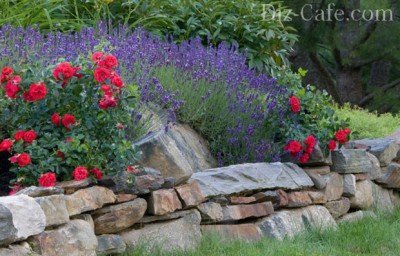

Harmonious blowing is formed when planting red ground cover roses together with lavender
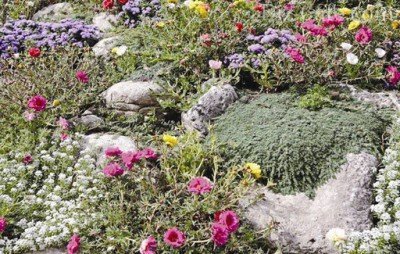

Creeping roses can be successfully included in the composition of an alpine slide
Growing from a seedling
The most convenient and efficient way to grow a plant is from a seedling.
How to choose and prepare a seedling for planting
It is better to purchase planting material in specialized stores or nurseries. This is a guarantee of obtaining the variety specified by the seller. High-quality seedlings should have at least 3 developed shoots and well-branched roots with small shoots. Since seedlings are obtained by grafting, you need to pay attention that the diameter of the rootstock and the scion is the same.
Seedlings can be sold in a container (in a net) or with an open rhizome. Roots of roses in the netting are often bent or broken. Therefore, before planting, they must be unpacked and shortened. But more often the earthen lump is not disturbed, and to stimulate the development of roots, an incision is made to a depth of 2 cm.
If the seedling is sold with an open root system, before planting, the sections need to be updated, hold the roots in water for a day to revive them. If roses are not planned to be planted right away, they are dropped in a cool place and covered with a damp burlap.
Before sending seedlings to open ground, they remove last year's leaves, old and weak branches. Choose healthy, external kidneys, make an oblique cut at a distance of 10-15 cm. Until planting, the roots should not be left open to the air. They should be in water with the addition of Kornevin or Epin, or be dug in with wet sand. It is recommended to disinfect seedlings with copper sulfate to prevent fungal infections.
Landing dates
In areas with warm winters, it is preferable to plant ground cover roses in the fall. In colder regions, it is best to do this in the spring. When planting in autumn, the shoots should be slightly shortened. In the spring, only 2-3 buds are left on each shoot.
Location selection and lighting
Roses love good lighting. If the sunlight falls correctly, it stimulates long-term flowering and bud formation. But under the direct scorching sun, leaves and petals can get burned. It is not recommended to plant flowers under trees, near walls, in the shade. This is bad for the development of the root system.
It is better to grow ground cover roses on the western or southeastern side of the site. It is good if the sun's rays hit them in the morning hours, and at noon they are protected from the scorching sun. It is preferable to plant seedlings at a slope on a hill, so that in the spring the melt water will drain faster. Roses do not respond well to high soil moisture. Therefore, it is not necessary to choose areas for them with closely located groundwater.
Reproduction of carpet roses
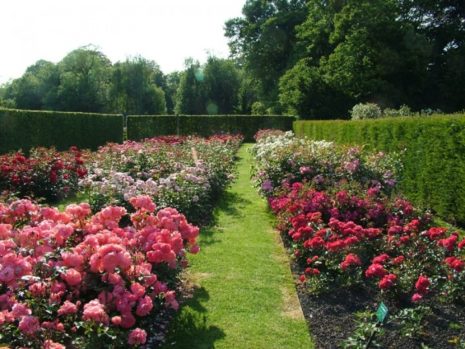

All varieties of these beautiful flowers reproduce mainly vegetatively - by layering, cuttings, dividing the bush, root suckers. When breeding ground cover species, gardeners most often use cuttings and layering, since these methods allow you to get new, well-developed bushes in a short time and without investment.
Layers
Roses creeping on the ground reproduce with the help of layering independently - the lashes take root in the knee. If there is a desire to help them, then it will be enough to dig a long shoot together with the buds with earth, leaving the end of the lash outside. The twig in the ground is watered abundantly all summer. By the fall, the shoot will grow over its own root system. Then it is separated from the mother plant and transplanted to a new place or moved to a pot so that the young bush overwinters in more comfortable conditions.
Cuttings
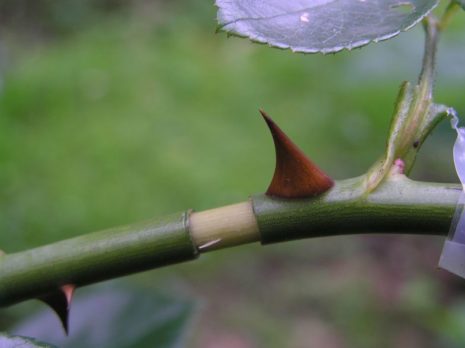

You can increase the population of ground cover roses in your area by cuttings.To do this, cuttings 15-20 centimeters long are cut from faded one-year-old semi-lignified shoots. Each stalk should have a smooth stem, 2-3 internodes and the same number of buds.
Note!
Cuttings are cut from the middle of the shoot. The ends of the branches for grafting are not suitable, since they have not yet ripened, which means that such cuttings will require much more time for rooting.
Before rooting, cuttings are cleaned of thorns and leaves. The lower part of the twig is dipped in a growth stimulator and planted in a light nutritious soil consisting of sand, humus (or peat and compost). The cuttings are deepened into the ground by 2-3 centimeters, so that the lower bud is located very close to the surface. The cuttings are rooted in a small groove or nursery covered with a film on top. To activate growth, the microclimate of an impromptu greenhouse must be warm and humid.
If rooting was carried out in the spring (from cuttings prepared in advance), then the planting of roses for permanent residence is carried out in the fall with obligatory shelter for the winter. When grafting in the fall, young bushes are planted in open ground only next spring, as soon as the ground warms up enough. In the first year, it is necessary to remove the maturing buds and monitor the moisture and cleanliness of the soil.
Purchase in the nursery
| How to choose
|
| Transport and storage
|
Outdoor care
Groundcover roses are not whimsical. They can cope with some care mistakes without too much trouble. But in order to ensure rapid growth and abundant flowering, it is necessary to provide the flower with elementary agrotechnical measures.
Watering
Young seedlings after planting require regular but moderate watering. It is necessary to let the soil dry 1-2 cm deep. Adult shrubs require an average of 1 watering per week. In hot, dry weather, their number increases. It is better to water the plant in the morning, use warm, settled water. Do not overfill roses. This is detrimental to the root system. In the fall, watering of ground cover roses is stopped.
Top dressing and fertilization
In the first year of planting, if the soil was filled with fertilizers, you do not need to feed the rose. Adult bushes need additional nutrition during the growing season.
The first time fertilization is applied after the appearance of the first leaves. Nitrogen-containing compositions are used to build up green mass. Before and during flowering, special fertilizers are applied for roses. At the end of the first wave of flowering (end of July), nitrogen can be added for the last time. Then it is excluded, otherwise the bushes will continue to grow and will not have time to prepare for wintering. In August and September, potassium-phosphorus fertilizers are applied, which form a stable immunity in roses, and increase winter hardiness. In the same period, it is recommended to replace one of the complex dressings with the introduction of organic matter.
Pruning
Unlike regular roses, groundcover roses do not require such careful pruning and can form on their own. Many growers generally recommend not cutting them in order to preserve their natural shape.
But there are also fans of trimming. The first year after planting, the roses can be trimmed a little for greater bushiness.Subsequently, regularly remove dry and damaged shoots, thin out too dense crown to ensure normal air circulation. It is recommended to rejuvenate the bush every 5-6 years. Shorten all branches, leaving only 15-20 cm of their length. Slices are made at an angle of 45 degrees, 1 cm back from the kidney.
Description
The main characteristic of a ground cover rose is its creeping or creeping stems. If you are not sure about the type of plant (some varieties may have an impressive height), pay attention to the proportions - the width of the bush will always significantly exceed the height.
The height of the bush can vary from 50 cm to 1.5 m.
These flowers have not only a decorative function, but also an excellent ability to strengthen slopes. Seedlings of ground cover roses are planted on slopes where it is necessary to prevent erosion and erosion. The wide root system forms a strong network that prevents soil collapse.


Flowers are distinguished by a wide range of colors of petals and sizes of inflorescences. In addition, they can be simple, like a rose hip and complex, terry. Branching stems, densely leafy. It is this feature that allows roses to form a dense carpet on the site, which will successfully cover the imperfections of the landscape.
Hanging and creeping stems are used both solo and in the design of hedges. Unlike climbing roses, ground cover ones have shorter stems, but more branching with abundant foliage. They cannot climb structures, but undersized varieties are actively used in microborders and even hanging pots.
Varieties and planting in the Moscow region
Ground cover roses blooming all summer for the Moscow region the following are suitable:
- White and pink kashion;
- white swoni;
- bright red fiona;
- red faerie dance;
- yellow sled rose.
All of these varieties are frost-hardy enough for any area. German varieties of larisa, popsicle, jazz tolerate well both cold and heat, and prolonged precipitation.
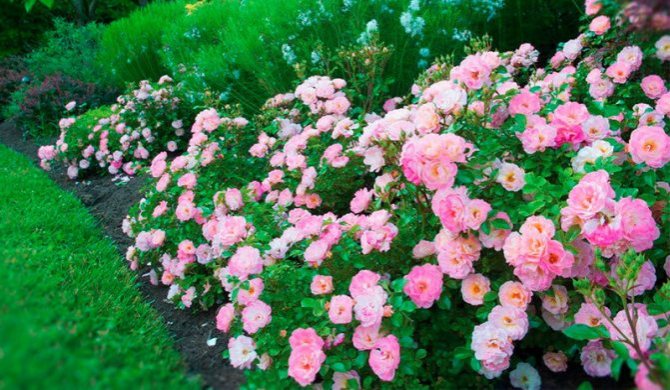

Particular attention should be paid to the soil where the plant is planned to be planted. A rose can always bloom, but for intensive growth and flowering it will need help. Given the peculiarities of soils in the North of the Moscow Region, before planting, the soil should not only be fertilized (mullein), but also reduced acidity (ash, chalk, dolomite flour, slaked lime). In the southern part of the Moscow region, one should not lower the acidity, but increase the nutritional value of the soil. For such purposes, peat, mullein, compost are suitable.
The best time to plant roses will be April (after the snow has completely melted) or October (before the frost begins). It is better to cover a new sprout for the winter in order to avoid freezing of an immature plant. Repeaters no longer need special measures to protect them from the cold.
When choosing a planting site, keep in mind that places that are heavily shaded by trees or fences, as well as swampy areas, an area too often blown by cold winds, are not suitable for roses.
The hole for planting a plant should be at least 20 cm deep. If the soil is too clogged, then the depth should be increased and drainage from sand, expanded clay, crushed stone should be laid. Compost is brought in. Before planting, the root shoots are shortened. The plant is immersed in a hole in such a way that 4-5 cm of the stem above the root also went into the ground. Water abundantly, cover with earth and trample.
Features of planting a ground cover rose in the garden
Groundcover roses are less demanding to care for and grow than other varieties of garden roses, but they also need sufficient care for their characteristics. We will try to summarize the basic points of planting and further care for these beautiful plants.
Choosing a place to plant a ground cover rose
An important point for obtaining a lush healthy bush of a ground cover rose is the right choice of a place for planting and an appropriate level of agricultural technology, in the future, caring for the blooming pride of the garden will be easy.
The place for planting roses should not be excessively wet and have close-lying groundwater, since in moist soil the roses will not have proper oxygen circulation, and in winter, in severe frosts, the roots can be overcooled and lead to the death of the entire plant. With increased soil moisture, soil drainage should be carried out using moisture-removing tubes.
The best soil for roses will be loamy, which will allow oxygen and water to pass to the root system. For improvement, stony and clay soils are diluted with a mixture of sand, peat, compost and bird droppings, and sandy soils - with a mixture of compost, peat, turf and clay. Favorable growth conditions will be in slightly acidic soils with a pH level of 5.5-6.5. Increased acidity can be neutralized with limestone or ash, and alkaline reactions with superphosphates.
Preparatory work before landing
How to plant a groundcover rose in the garden
Planting ground cover roses is within the power of even a novice gardener.
First you need to prepare a nutritious soil mixture - mix garden soil, turf, sand, clay, peat, humus in a bucket of each of the ingredients, add 100 g of superphosphate and ash. A layer of bird manure about 10 cm thick is poured into a hole dug out in 15-20 days. Then a small mound is formed from the nutrient soil in the center of the planting hole, on which the seedling is placed.
The roots of the plant should be evenly spread for better growth and rooting, after which you can add soil mixture, periodically shaking the seedling to better fill the inter-root space with earth. After the planting hole is filled with soil, it should be tamped, poured with a bucket of warm water and the seedling should be covered with an earthen mound of 15-20 cm. It is recommended to shade the seedling for 10-15 days after planting.
Protection from pests and diseases
Most ground cover roses are disease resistant. But over time, pathogens of various infections adapt to new conditions and can infect healthy plants. More often, infectious diseases in roses are caused by fungi, which form a mycelium, spreading not only to all parts of the plant, but also to the ground. Fungal spores can persist for a very long time, even on dead plant debris and be a threat of infection for healthy plants.
A groundcover rose can be infected by:
- powdery mildew;
- rust;
- black spot.
To save the plant, you must first remove the affected stems and leaves, burn them. Spray the bush with copper sulfate and a fungicide solution (Topaz, Fitosporin, Fundazol).
Of the pests, the rose can be affected by:
Additional tips and tricks
Groundcover roses are used to create bright spots on the site or hedges. Some varieties of this plant are grown individually in pots. A number of ground cover roses are recommended to be planted to decorate gazebos or gates. In order to prevent the appearance of diseases, shrubs must be watered moderately, avoiding waterlogging of the soil.
Deciphering the icons on the clothes Test for cleanliness in your home Laundry weight calculator for washing Ask an expert
Share link:
Fertilizer
The bush of the first year of planting is not fed. But next year, fertilizer is scattered over the melted snow in the amount of 50-70 grams per square meter of plantings. They use complete complexes of mineral fertilizers.
Complex composition: 1 (nitrogen) - 2 (phosphorus) - 1 (potassium). Two weeks later, they are fed with organic fertilizers: infusion of manure (horse, cow) or bird droppings.
A month later, they are again fed with mineral fertilizers. Use the same composition or take a nitrophosphate with Azophos. When the roses begin to bloom, they are not fed.
After the end of the first wave of flowering, phosphorus-potassium fertilizers are applied to stimulate the second wave in re-flowering roses. Nitrogen is discontinued as it induces new shoot growth and foliage.If you do not stop giving them, then the rose will waste energy and go into the winter weakened.
In September, to increase the plant's immunity and its immunity to low temperatures, potash fertilizer (potassium magnesium) is applied.
Reproduction
Ground cover roses are propagated in different ways. Seed at home is practically not used. It is interesting for breeders to develop new varieties. Simpler and more effective vegetative methods: layering and cuttings.
Layers
In early spring, bend the young shoot to the ground several times. This way you can get several new plants from one shoot. Do not deepen the outermost buds into the ground. Fix the shoot in small holes filled with nutritious soil. During rooting, the cuttings need to be watered frequently. In the fall, they can be separated from the main bush and transplanted to a permanent place.
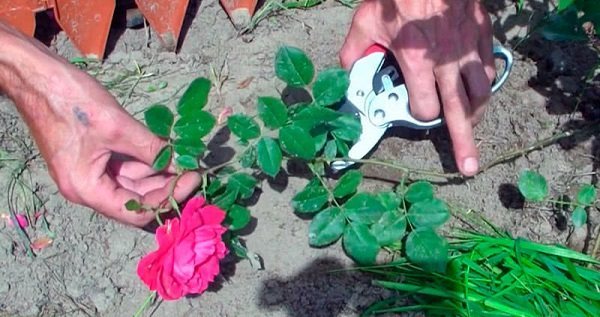

Cuttings
The procedure is best done in late summer - early autumn. Cut green, well-ripened shoots. Each must have at least 3 thick internodes. The cut sites should be under the lower kidney. Apical cuttings are not suitable for propagation. It is better to take shoots with a part of the stem of the skeletal branch (heel).
Gently break off all the thorns, remove the lower leaves. Place the cuttings in Epin's solution for a couple of hours. Choose a shaded place on the site, make a trench 15 cm deep. Cover 1/3 of the depth with sand. Place the cuttings at a distance of 15 cm from each other. The bud that is underneath the bottom leaf should almost touch the ground. Sprinkle a trench and compact the soil a little. It is advisable to install a plate indicating the type of rose. Water the plants regularly, pick off the buds. For the next fall, they can be transplanted to a permanent place.
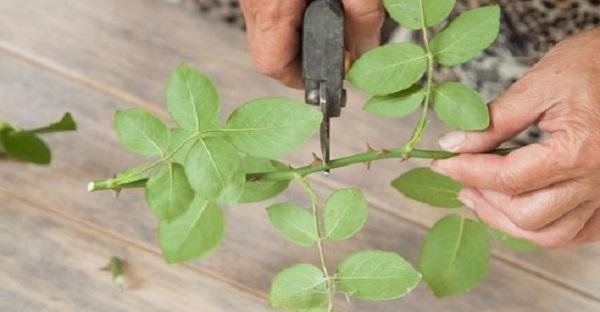

Growing and care rules
Carpet roses are resistant plants, therefore, under unfavorable environmental conditions, they practically do not get sick and do not die. But with improper care, their decorative effect may decrease.
Caring for carpet flowers consists of regular watering, soil mulching, dressing and pruning.
After planting plants in open ground, the land should be mulched using peat or humus. Mulch will help to avoid rapid evaporation of moisture and the appearance of weeds. Mulching must be carried out immediately after planting the seedlings on the site, since later the creeping shoots will cover the ground, which will complicate the process of this procedure.
Read also: How to properly transplant aloe at home
In the first two weeks after planting, young bushes are watered abundantly and often. In the future, watering is reduced, since the long roots of roses are able to extract nutrients at the level of the lower layers of the soil. The next moistening is carried out only when the soil is completely dry.
Carpet roses respond well to regular feeding, but they should be applied the next year after planting. If the plants do not receive additional substances, then they will not tolerate wintering well and will not give a violent and long flowering. Flowers are fed 6-7 times in one season.
As you can see, caring for ground cover roses is quite simple, so even a beginner can handle them. If you do not forget to take care of the plant, you can regularly enjoy a wide carpet of variegated or delicate colors of richly blooming roses.
Landing
The main difference when planting ground cover roses is that you need to prepare the entire area of land that it will cover during growth. This territory is dug up, weeds are removed, and mulched. Treat with a herbicide, such as Roundup, but this is not necessary.
Suitable for mulch:
- black non-woven fabric;
- compost;
- sawdust;
- dried cut grass;
- decorative chips.
Mulching is necessary because it is very difficult to remove weeds after overgrowth. And if this is not done, the rose garden will lose its attractiveness. When the bush comes into force, the dense foliage and abundant flowers will suppress the growth of weeds. Then mulching will lose its relevance.
Roses love the sun, but not scorching.Otherwise, delicate petals will lose their brightness. Therefore, they are planted in the southeastern or southwestern part of the garden.
To prevent the roots from being heated by rains, they are planted in raised areas. If several plants are planted, then the distance between them depends on the selected variety. It can be from half a meter to three meters.
The width and length of the planting pit is 50 cm, and the depth depends on the size of the roots. The time for planting is chosen depending on the climatic conditions. In central Russia, this is usually done in the spring.
Seedlings are carefully examined before planting. The cuts of the roots are renewed, damaged ones are removed, they are shortened too long to 30 cm, and immersed in water for a day. If planting occurs in the spring, then the shoots are cut to two or four buds.
For better survival of the plant, the roots are dipped in a mash made of clay and manure before planting. At the bottom of the planting pit, a mound is poured from a mixture of humus and sod soil. They put a bush on it, straighten the roots, sprinkle it with earth. The grafting site is deepened by 5 cm. Around the bush, an earthen roller is made so that water does not spread during watering. Then it is poured abundantly with water and mulched with compost, peat, sawdust.
Preparing for landing
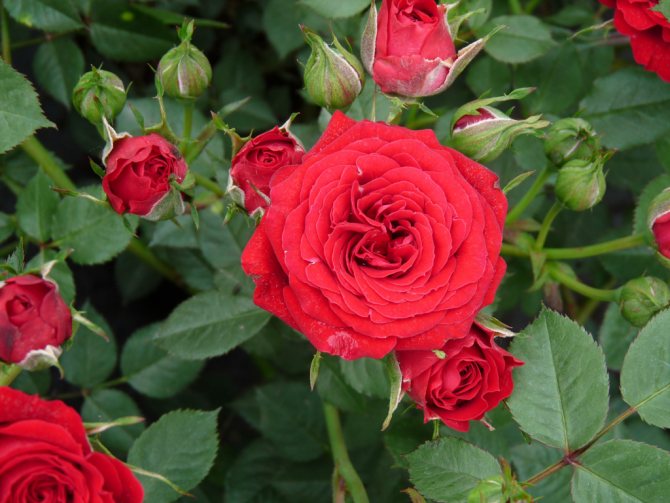

The presumptive landing site must initially be dug up. When digging, it is also important to remove the roots of the weeds from the ground. After the procedure, the soil is loosened with an appropriate tool. It is necessary to prepare the entire proposed area where flowers will grow. Ground cover roses grow quickly enough, so very soon the whole territory will be overgrown with a bush.
To plant the root, you need to dig a hole half a meter deep and wide. The distance between the bushes should be between thirty centimeters and a meter. Do not worry if the existing root of the bush is small and frail, very soon it will grow and will be able to show all its strength.
Autumn care, shelter for the winter
For ground cover roses in the fall, care is practically not needed, but it is important to carry out sanitary pruning in a timely manner. Most varieties are highly frost-resistant and can winter normally under snow. But if the winters are frosty and snowless, it is better to play it safe and cover the bushes. In the fall, when it gets cold enough, the roses are sprinkled with pine spruce branches. Before that, lay the long stems on the ground. In the spring, remove the shelter when the frosts have passed, in order to prevent the plant from drying out and decay.
Preparing roses for wintering
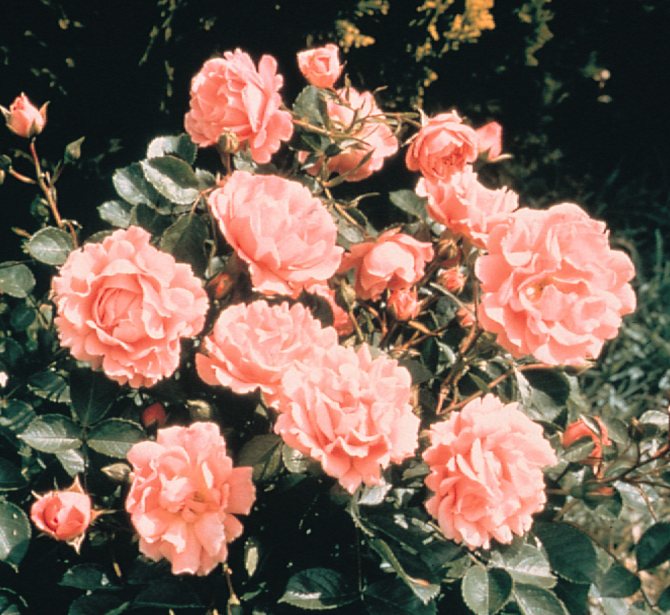

A groundcover rose does not need special care in the fall; it is enough to partially clean it. This type of rose perfectly tolerates cold weather. Of course, if the winter is snowless and fierce, then the bush can be covered with branches of coniferous trees. Firstly, this option will insulate the root system from frost, and secondly, rodents will not be able to harm the flower. If the stems of the rose have grown, and you do not want to shorten them, then for the winter period it is better to lay the sprouts on the surface. Shelter for roses should be done with the onset of the first cold weather and cleaned up when it warms. If the shelter is not removed in time in spring, this can lead to rotting of the root system and stem.
Florist reviews
Mouse
Groundcover Hello. I do not cover with anything, hibernates under a huge piled snowdrift. In the spring I cut my hair that is blackened, stale from the snow cap, and sometimes it is short! but recovers quickly.
Marussia
I would of course choose Palmengarten. Without a shadow of doubt! First of all, due to the fact that her bush shape is much more harmonious. I tie it up a little, of course, but in moderation.
Features of the
The best roses for the Moscow region must meet special requirements, namely, be frost-resistant, since the climate in this region does not please with warmth. Spring comes late, and winter begins early, so the flowers must have time to collect foliage, inflorescences. It is equally important to consider how the plant survives severe frosts. Most of the roses grown in the southern regions of the country could not survive the winter or they would have to be covered additionally, otherwise the bushes would simply die.
It is the plant's endurance that is preferred when planting. After many studies, it was found that Canadian and English non-covering varieties are best suited for the Moscow region.
Differences from other roses
Distinctive features of this group of roses:
- fast growing shoots;
- highly branching bushes;
- abundant, long flowering;
- good immunity, resistance to low temperatures, fungal diseases and pests;
- no need for careful pruning.
The height ranges from 20 cm to 2 meters. The variety of all these properties makes them look like Miniature, Scrub, Climbing roses. It is even difficult to classify them. One and the same variety is recorded in different groups in the catalogs of different companies. So the Bonika 82 variety is included in the ground cover group and in mini-shrubs. And the Sommerwind variety is simultaneously considered a ground cover rose and a floribunda.
In some issues of landscaping the site, they are interchangeable. Some use climbing roses as a ground cover, spreading them on the ground. But still, for vertical gardening, it is better to use climbing roses, and for horizontal gardening, groundcover.
Varieties of flowers
The group called "ground cover" includes dozens of species. Therefore, when choosing a flower, you need to compare the characteristics of the species you like with the conditions of the region.
Winter hardy
One of the brightest representatives is the Fairy variety. A compact bush with falling shoots. Plant height - 60-80 centimeters. The leaves are dark green, small, with a glossy surface. The variety is not afraid of cold, disease and shading. A winter-hardy species called Hello. The bush is 30-50 centimeters high. Double flowers with a diameter of 5-6 centimeters, consist of 110-120 petals. At the beginning of flowering, the color is dark cherry.
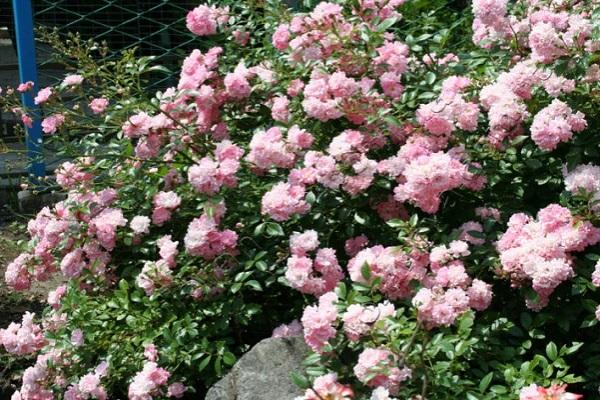

Resistance to known diseases
Scarlett is a tall shrub with double flowers 3-4 centimeters in diameter, painted cherry red. The height ranges from 1 to 1.5 meters. The rose is highly resistant to disease and tolerates winter well.
Plants of the Fair Play variety are large, spreading: diameter - 2, height - 1 meter. The flowers are pink, semi-double. There are up to 50 of them in one inflorescence. The bush is used to decorate slopes and curbs.
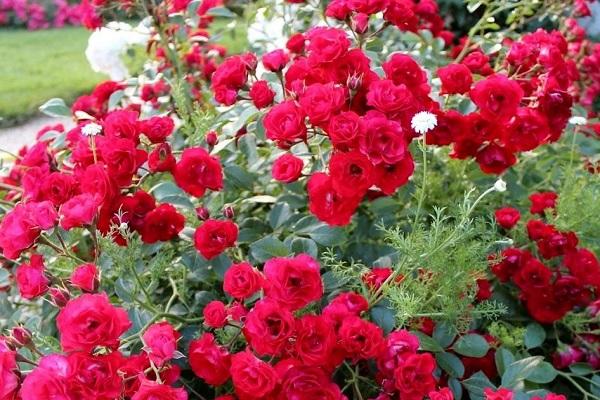

The most beautiful
The Swoney variety surprises with the beauty of even sophisticated flower growers. Sprawling bush, densely covered with white terry flower rosettes with a pink dot in the center. One branch contains 5-20 flowers. The width of the plant is 1.5 meters, the height is 0.6-0.7. The species has a high immunity to powdery mildew.
Ballerina is the most beautiful species in the 2001 Rose Growth Competition. Plant height - 70-90 centimeters, width - 120. Flowers 4-5 centimeters in diameter, pink, with a white dot in the center. The brush consists of 40-50 flowers.
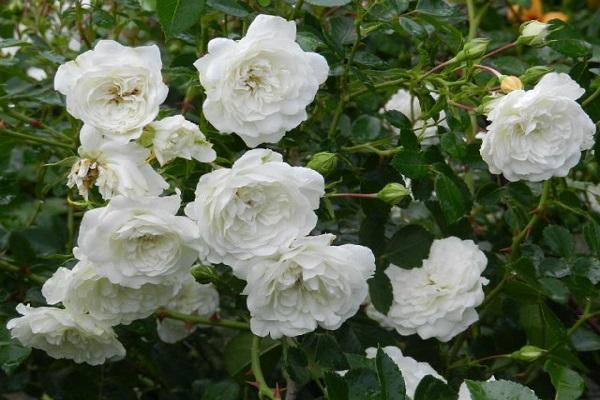

Varieties, description
In the modern assortment there are many varieties of ground cover roses, the most famous of them are: Gold Cover, The Fairy, Alba Maidiland, Besy, Ondela, Nozomi, Snow Carpet ( Snow Carpet, Repandia, Max Graf, Mirato, Super Dorothy, Snow Ballet, Candy Rose, Pink Spray, Fairy Fairy Dance, Fieurette, Max Graf, Immensee, Sea Foam, Rote Max Graf, Swany, Scarlet Meidiland , AlbaMeillandecor, AspirinRose, Satina, Palmengarten Frankfurt, MagicMeillandecor, PearlMirato ('PearlMirato'), Austriana Haze, Red Haze, Supreme Cover. Let's consider a few of them in more detail.
The Fairy
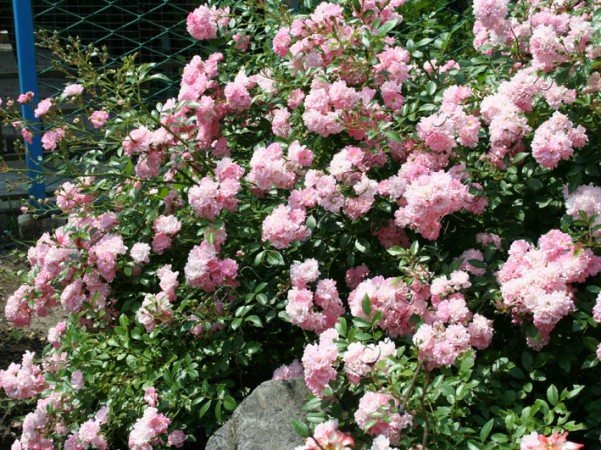

Ze Fairey is one of the most popular ground cover varieties in the world. The species belongs to the Bentall collection, England and, according to the international classification, belongs to the polyanthus group of roses, but here, in Russia, in the middle lane, it is included in the ground cover group.
A wonderful plant of delicate dark pink color. Although the shade is retained for a long time (especially in cold weather), it tends to fade under the yoke of sunlight to pale pink, or even white. The buds are placed on small peduncles of 20-40 pcs., Small, up to 4 cm in diameter, terry (up to 50 wavy, such that bend towards the center of the petals), collected in inflorescence brushes.Flowering occurs in waves, almost continuously (from June to October) until late autumn, especially plentiful in early summer, luxuriantly and completely covering the ground.
The Ze Fairey bush is small (up to 70 cm), wide, spreading, with drooping arched branches, has small, dark green, shiny leaves. There is a good musky or apple aroma. An unpretentious bush can grow in partial shade, it is quite resistant to cold and disease. Ground cover variety "The Fairy" has many world awards: 1997-2001 - "Best Polyanthus Rose" at the American AARS Rose Competitions (USA and Canada). They are used in group planting in a rose garden, in curbs, as a low hedge, as a standard tree, for cutting, flower beds in the foreground, along paths, in container culture.
Fairy Dance
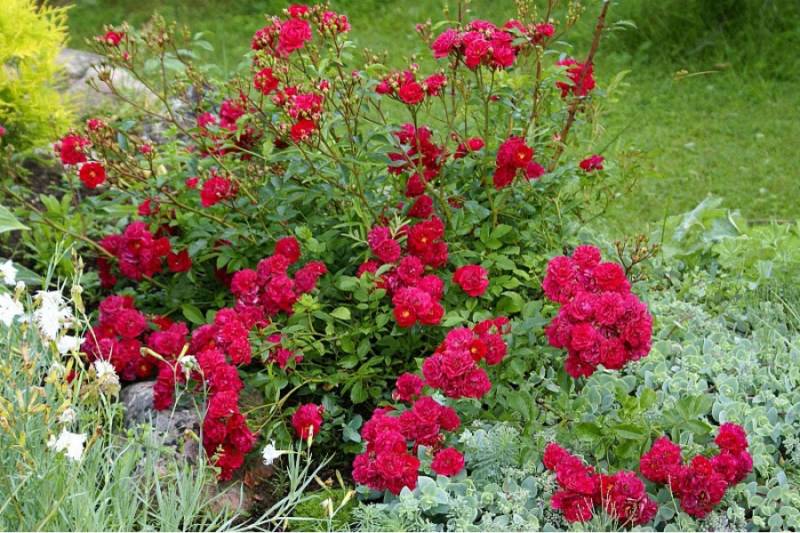

The best roses for the Moscow region
Growing spectacular lushly blooming roses in the suburbs once seemed to me an impossible task. However, with the right selection of varieties, it is easy to create a luxurious rose garden to the envy of southerners. Each group of roses has its own stars, which amaze with luxurious flowering and become a worthy decoration of the garden.
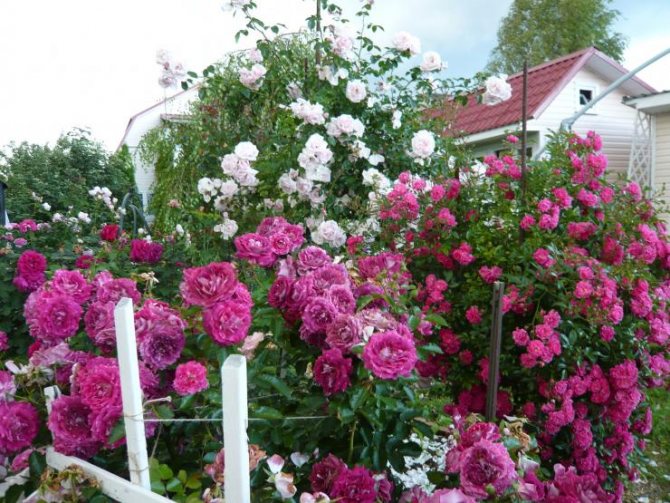

Climbing roses for the Moscow region
The most stable group of roses for the Moscow region is, perhaps, climbing.
- The varieties suitable for the climate are resistant.
- Flowering is spectacular and long
- Climbing roses are easiest to lay for the winter.
Both ramblers and climbers always lie under a 30-centimeter shelter, thanks to which they find themselves under the snow and winter well.
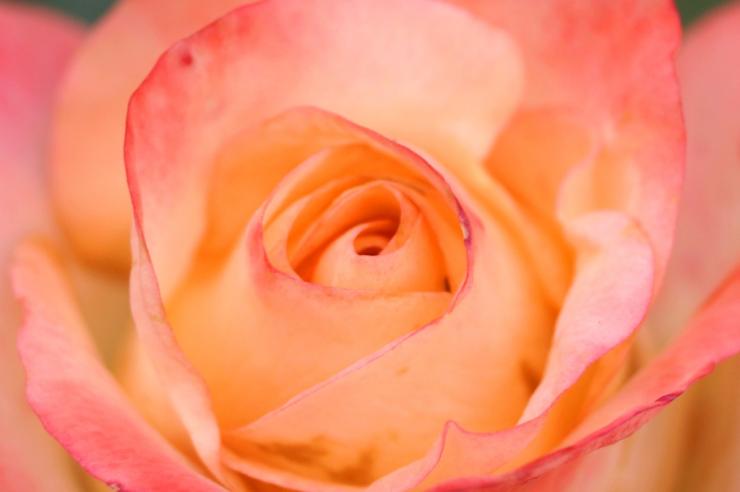

New Dawn
One of the most unpretentious climbing roses is the variety New dawn.
- Differs in increased winter hardiness and strong growth of shoots. Once she spent a frosty winter with little snow in my garden under one layer of cardboard. This did not affect her health in the least.
- This is the only rose that can grow in the shade of a fence.
- It is almost unaffected by black spot.
- The only drawback is the small flowers, which now seem to me somewhat inconspicuous.
- The variety has a rather long flowering period from mid-June. Leaves on vacation from the end of August In September, it pleases only with rare flowers.
- The buds cannot stand frost -2 ° C.
I have a rose in my garden New dawn grows in 2 variants:
- on the trunk (the most advantageous option for it is the 2-meter height of the trunk);
- like climbing.
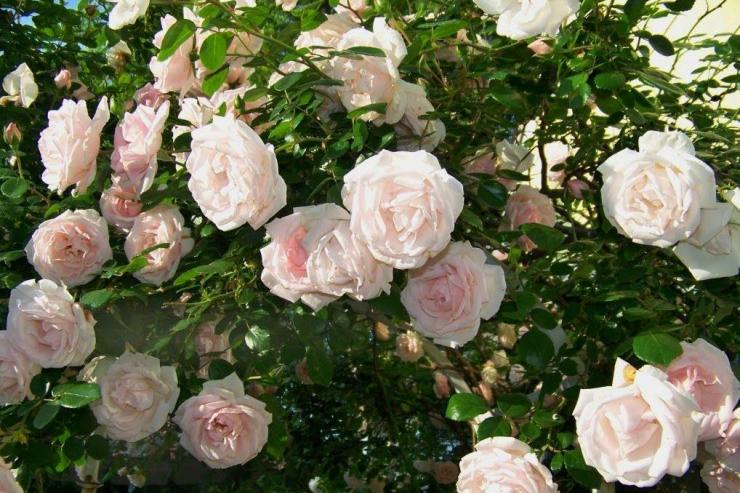

Photo: rose New Dawn
Perennial Blue
An absolutely stable, effective and unpretentious novelty is the variety Perennial blue... Roses have lilac - purple inflorescences in the form of long brushes, located parallel to the ground. For 2 years, the rose has completely encircled a 2-meter arch in my garden near Moscow.
- The rose blooms twice. Moreover, the first wave of flowering is more modest than the second.
- The first flowering occurs in June, the flowers are located on the shoots of the last year.
- The second bloom occurs on new shoots, starts in July and lasts until the end of August. The flower clusters are much longer and more luxuriant than during the first flowering.
- The rose has soft shoots, it is a pleasure to lay them for the winter.
- Shoots are capable of spiraling. However, it is better not to allow this, because in the fall it will take a long time to unravel and remove them from the support.
In addition to the lilac color, there is a variety with white inflorescences - Perennial blush... It is also unpretentious in leaving, it looks especially impressive against a dark background.
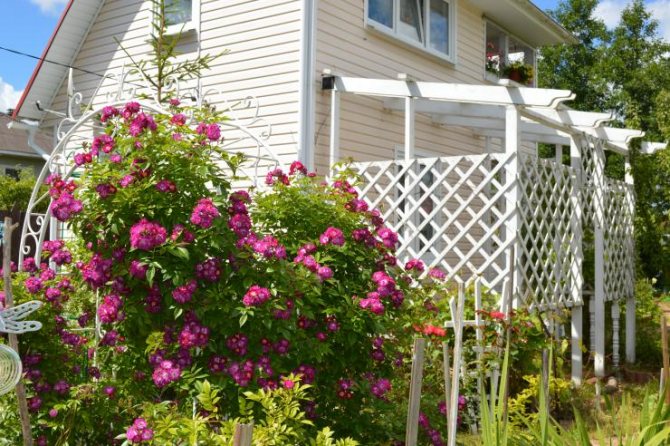

Photo: Rose Perennial Blue
Camelot
Relatively new variety Camelot showed itself in all its glory not immediately. The first 2 years bloomed inconspicuous single flowers that lasted only a few days. It turned out that the rose needed time to enter into the force, as they say, "grow".
- For 3 years, the rose has grown to 2.5 m, gave about 12 shoots. Their number increases every year.
- And in flowering, she began to behave differently: the buds dissolve evenly, stretching for a month and a half.
- Each inflorescence has 5-7 buds of a soft pink color with interesting shading. True, the rose blooms once, although double blooming is declared in the catalogs.
- He makes a minimum of requirements for a winter shelter, which makes me very happy.
The most difficult thing is to lay thick lignified shoots. I use a heavy wooden shield as a load, it also serves as her only shelter. When bending this, like any other climbing rose, for the winter, you need to bend the ends of the shoots to form an "arc". If the shoots are bent from the root, the break cannot be avoided.
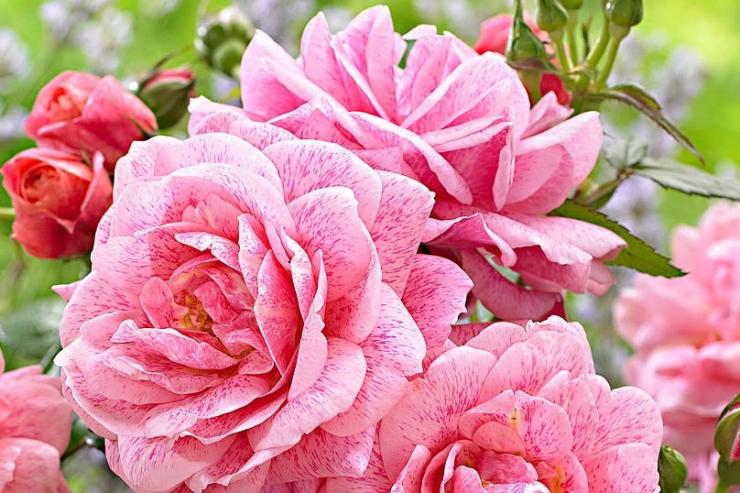

Photo: rose Camelot
Amadeus
The rose also demonstrates excellent qualities. Amadeus... Its bright burgundy - red inflorescences, 5-11 pieces collected in a brush, are a real decoration of the site. The only difficulty in leaving is the stiff shoots, which must be laid for the winter in several steps so as not to break.
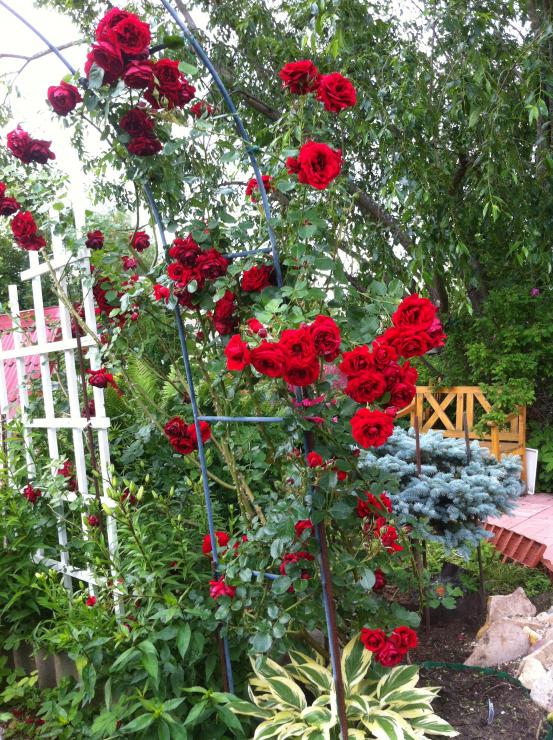

Photo: rose Amadeus
Flammentanz
Popular rose Flammentance known for its unpretentiousness. However, in my garden, on the contrary, it showed itself not from the best side. Given her unpretentiousness, I assigned her a place in partial shade, by the fence. As it turned out, in vain, because the rose froze in growth and was prone to black spot.
I believe that it can be unpretentious only in ideal conditions and in full sun. But in my garden there are few such vacancies, and they are given to hybrid tea roses. Therefore, due to lack of space, I had to from the variety Flammentance refuse.
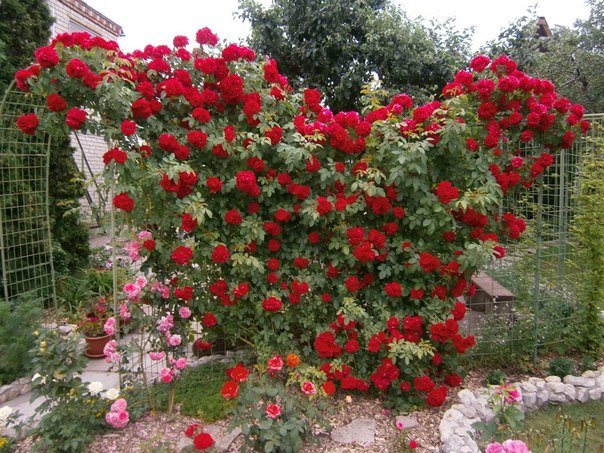

Photo: Rose Flammentanz
Rosarium Uetersen
Completing the list of climbing roses is a variety of unsurpassed beauty Rosarium Uetersen, which I deliberately assigned a place at the end of the list. At first, she made me worry: it did not give growth and wintered very badly, the branches froze by 1/3. As it turned out, the rose took time to adapt to the climate of the site. It took about 5 years in my garden. Time passed, and the rose turned into a real beauty.
- At the moment, this is the only rose that does not show "legs". She manages to grow in height, and generously gives new shoots from the root.
- By the splendor of flowering, it has no equal in the climbing group.
- Terry flowers, collected 12-15 pieces in each brush, make me admire this rich beauty every time.
- There are no breaks in flowering.
- The petals can withstand even October frosts down to -5 ° C.
Now the rose is 11 years old, her height is 1.5 m, and every year she only becomes more magnificent.
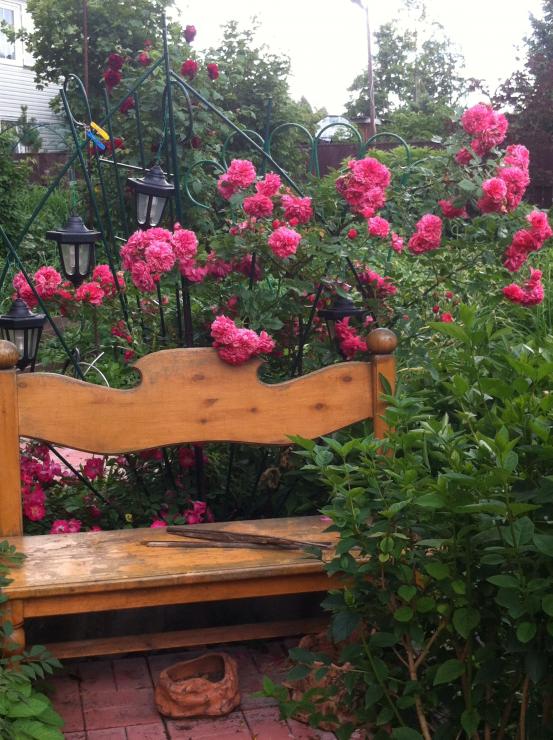

Photo: Rosarium Uetersen rose
Hybrid tea roses for Moscow region
I decided not to start a group of hybrid tea roses right away. They were frightened by the talk that the varieties are extremely unstable in the climate near Moscow. I really wanted to grow real goblet flowers on long stems - the kind of roses that are sold in flower shops.
The secret of successfully growing hybrid tea roses in the Moscow region is choosing the right breeder.
They are distinguished by the greatest winter hardiness and frost resistance roses by William Cordes (German roses W. Kordes) and David Austin (English roses David Austin). From these groups, you can safely choose any varieties, all of them are loyal to the winters near Moscow.
But from buying roses Meilland (Meilland) Better abstain. All of them are grafted onto a stock that is not hardy in our conditions. In the case when in the Mayan firm any variety has sunk into the soul especially, you can look for it from another originator, for example, from Cordes, where the stock is more winter-hardy.
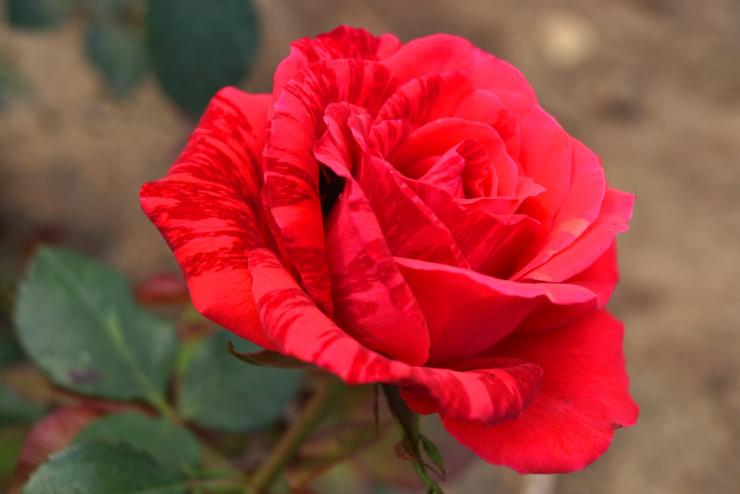

Acapella
In my garden, 2 varieties of hybrid tea roses demonstrate special resistance to the adversity of the climate, one of them is a two-color variety Acapella... I chose it because of the contrasting colors: crimson petals on the front side and white on the inside. For me, this rose has grown above the declared height and has reached 1.5 m. The rose is distinguished by two-fold, and with a warm favorable autumn and three-fold flowering.
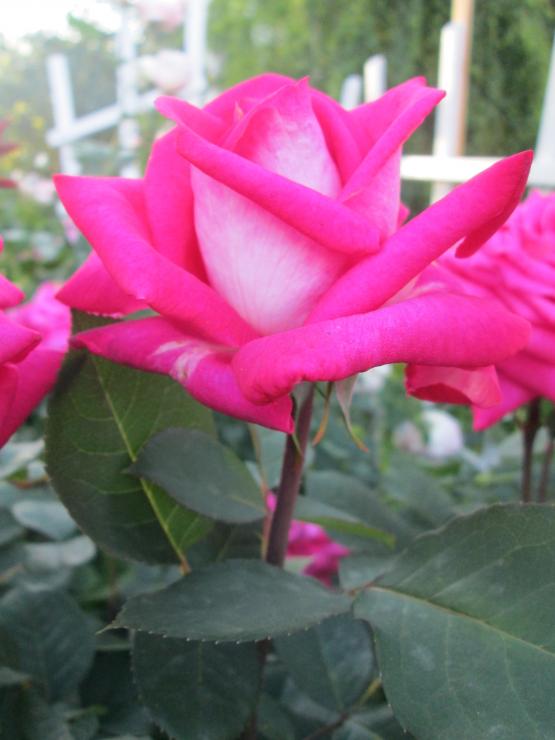

Photo: rose Acapella
My Girl
Snow white My girl looks impressive next to the variety Acapella... She also grows over the season much higher than her intended height. It blooms three times at intervals of 2 weeks.Its pointed tips of petals give it away the true queen among the hybrid tea group.
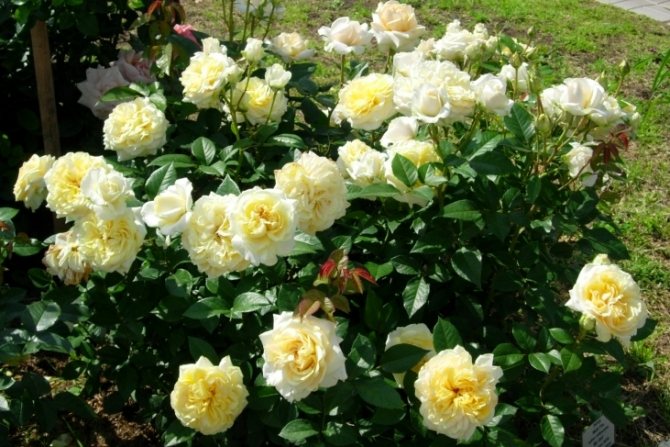

Photo: My Girl
Henri Matisse (Henri Matisse) and Claude Monet (Claude Monet)
Roses Henri matisse and Claude monet from the series "Great Artists". Like other varieties of the series, they have shading on the petal, are extremely unpretentious, bloom continuously.
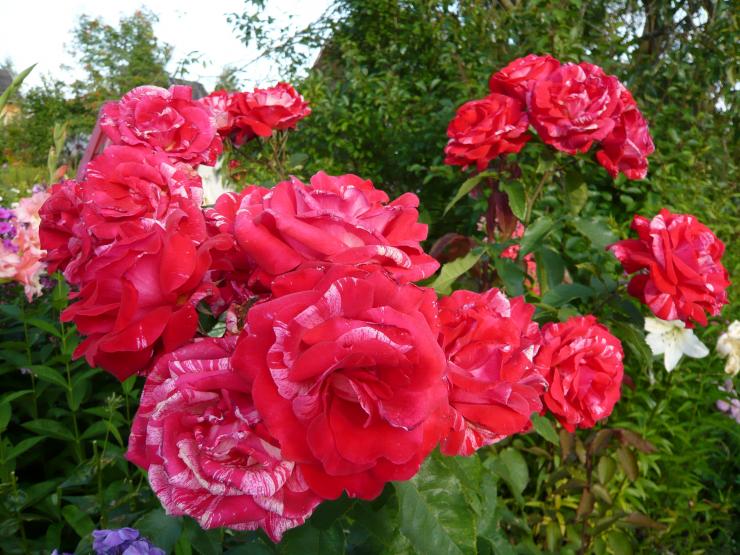

Photo: rose Henri Matisse
It so happened that the year before last I had to transplant Claude monet in the very heat (it was drowned out by the lilies of LO-hybrids) and drastically cut off. Rose did not even notice the transplant, and by the fall she had built up an excellent leaf mass.
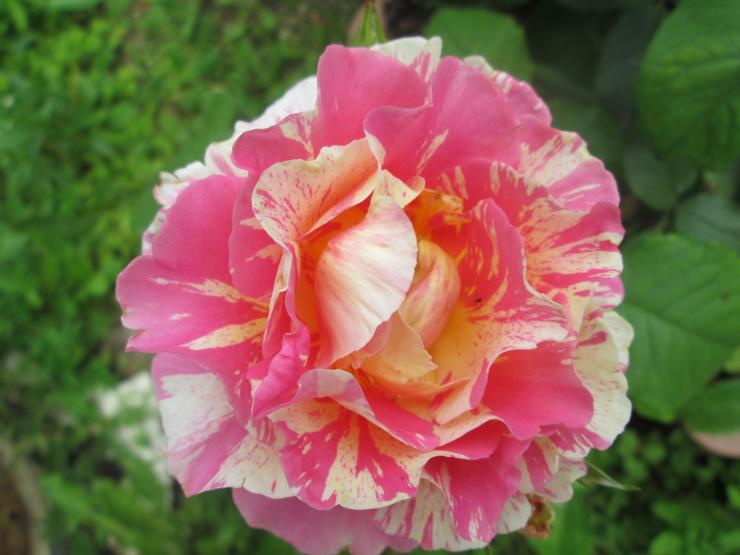

Photo: rose Claude Monet
Piano
Another bright representative of the group of hybrid tea roses Piano with a deep red tone and burgundy sheen of petals.
- Its flowers are in the shape of a bowl, each of which is filled with so many petals that it is impossible to count.
- The rose has strong shoots up to 1 m tall and beautiful glossy foliage.
- A pleasant moment is the ability of a rose to maintain an attractive appearance even after prolonged rains, which is characteristic of few varieties.
- Winter hardiness is excellent.
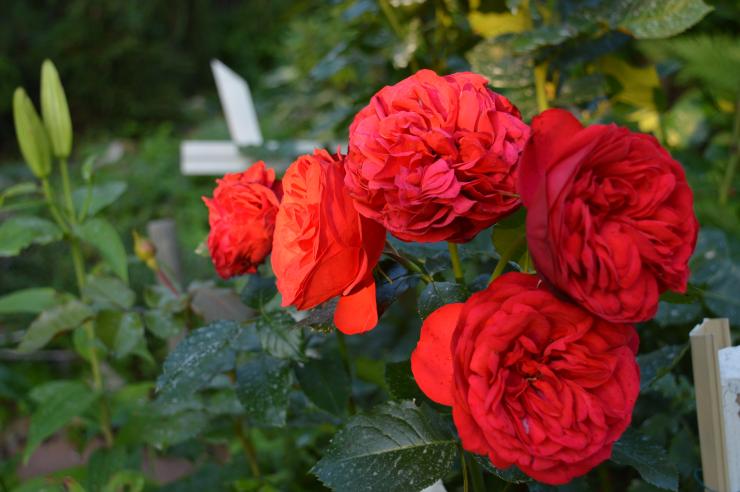

Photo: Rose Piano
For 20 years of communication with roses, I came to the conclusion that you can grow any hybrid tea roses. The main thing is to make a common rose garden for them, and not to plant 1 piece in flower beds. The larger the area of the rose garden, the more air there is in it, which means that the chances of a successful wintering increase.
My rose garden is 9X3 m in size.In the center (where the ground does not freeze even in severe frosts) I planted hybrid tea roses Acapella, My girl and others. Along the edges I planted a group floribunda and ground cover (eg, Aspirin rose), from the sides took the place Claude monet and Henri matisse... Although they belong to the hybrid tea group, they will give a head start to ground cover in terms of winter hardiness.
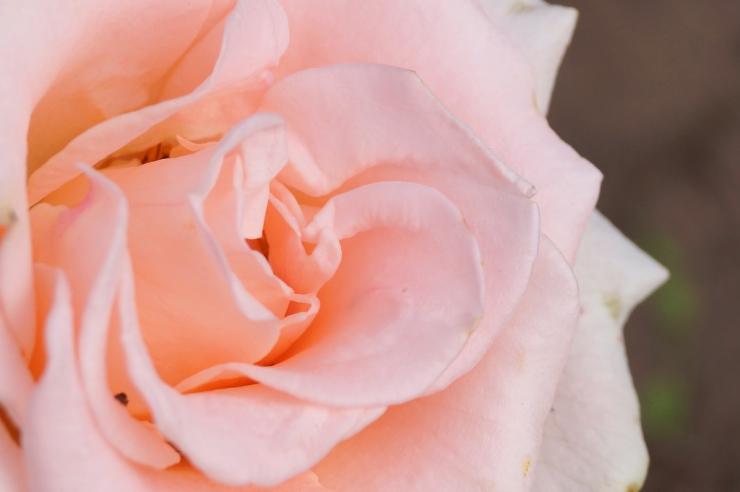

Floribunda roses for Moscow region
Floribunda are unpretentious and winter-hardy. Roses of this group are distinguished by their multifloral nature: several flowers are formed on one shoot.
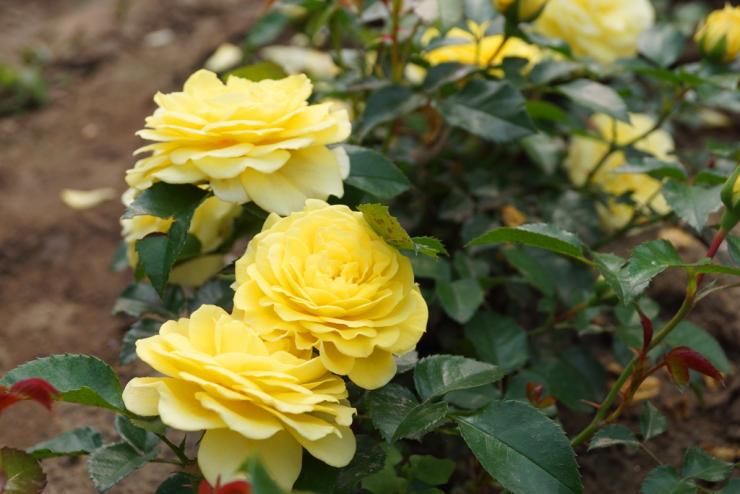

Let’s Celebrate
The floribunda group was impressed by the rose Let’s Celebrate - a novelty of recent years. In the conditions of the Moscow region, it blooms continuously and so abundantly that I do not have time to cut off the faded flowers. True, it is not necessary to do this with her, after a while she dumps them herself.
- The beauty blooms from mid-June to mid-September,
- does not stretch
- keeps a compact shape.
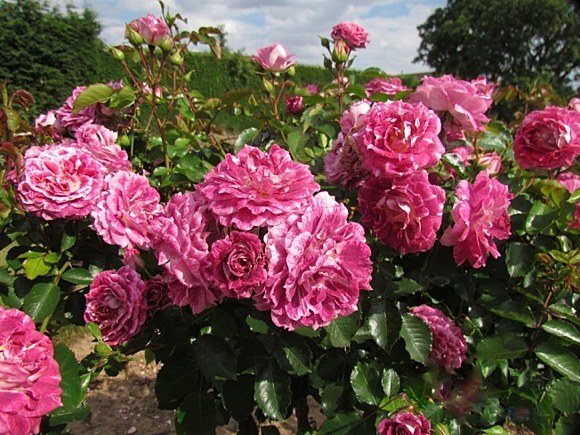

Photo: Rose Let’s Celebrate
Eyes for You
Another unique rose Eyes for you really so good that it invariably attracts the eyes. It happens that it is confused with peonies - the flower looks so unusual.
- The rose is one of the first to bloom in the rose garden, already at the end of May.
- It blooms twice, but the second bloom is more modest.
- Flowers are collected in clusters, which end each shoot, due to which leaves are almost invisible during flowering, only the caps of flowers.
- At the base of each petal there is a purple-blue spot that closes into a wide circle around the middle.
- The center of the rose flower with large fluffy stamens, which look contrasting against the background of a purple spot on the petals, has a special charm.
- As befits floribundas, the rose is unpretentious and winter-hardy.
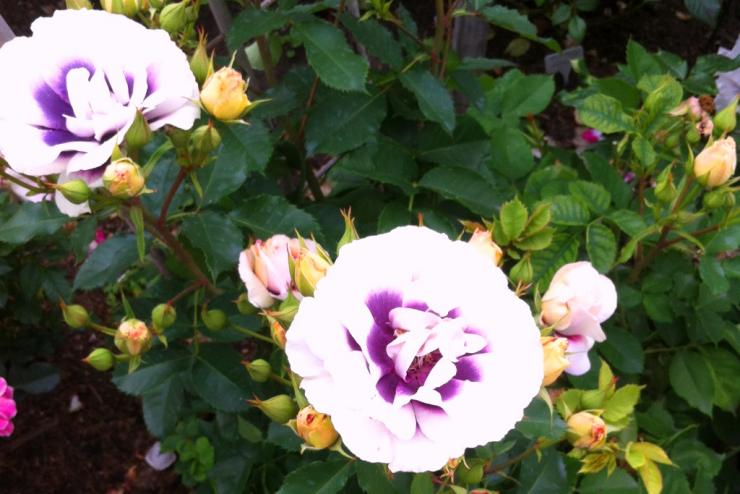

Photo: Rose Eyes for You
Gebruder Grimm
Another spectacular floribunda is a varietyGebruder Grimm (Brothers Grimm). The inner side of the petals is orange, and the outer side is yellow. Over time, the rose changes color to peach. It is absolutely winter-hardy and unpretentious, the only drawback is slightly weak shoots, which fall down under the weight of flowers, so you cannot do without supports.
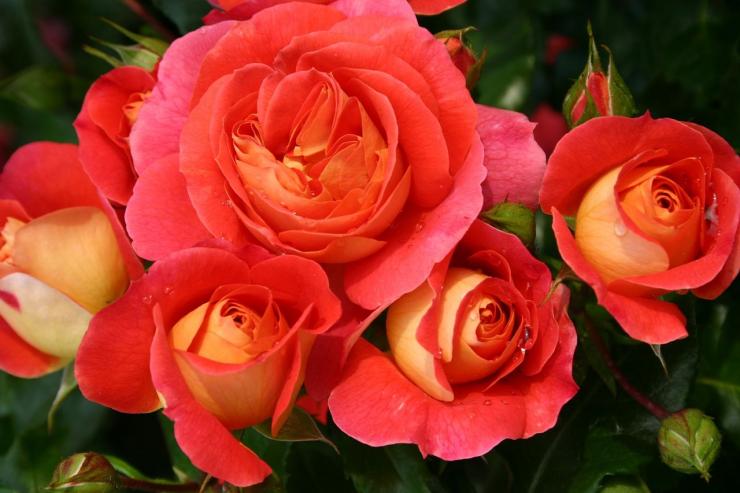

Bordure Abricot
In a company with her, an equally outstanding variety looks great Bordure abricot... Has similar characteristics, but sturdier stems.
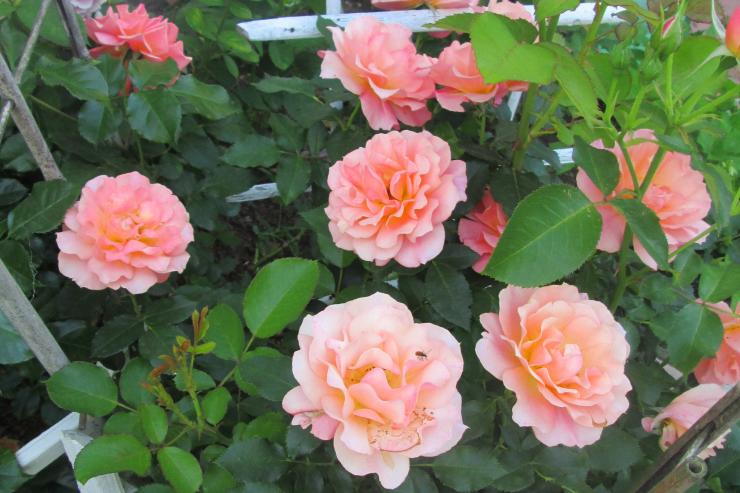

Photo: rose Bordure Abricot
Blue for You
There is a floribunda in the group and a representative of the rich blue color, so desired by many gardeners. Variety Blue for you has a really rich blue-blue tone. This is the best variety if you are looking for a blue rose.
- The rose grows to a height of about 1 m,
- the shoots are strong, erect,
- flower brushes are arranged in caps of 5-7 colors.
- The rose has excellent winter hardiness,
- suitable for background rosary and single compositions.
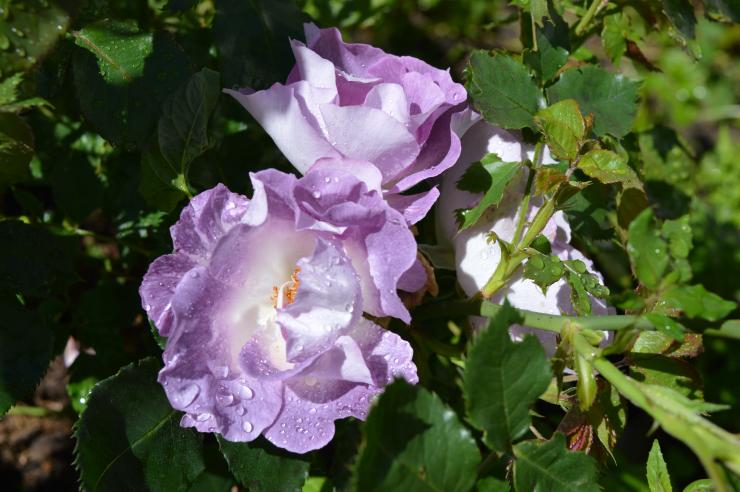

Photo: Rose Blue for You
Roses Shrabs for Moscow Region
Among the scrubs, the bright Robusta. Some catalogs classify it as a rose hip variety. It blooms all summer, takes a break for two weeks, forms a fluffy bush up to 1-1.5 m high.
For the winter, I still bend its branches with a heavy wooden shield and put a piece of roofing material on top. Once I tried to leave her without shelter, as some publications recommend to do with scrubs. The result was disastrous: the rose had to build up all the branches from scratch, that year it did not bloom.
Since then, I have closed all the roses for the winter, and in 10 years there have been no attacks.
Svetlana Samoilova, amateur florist, collector of rare plants
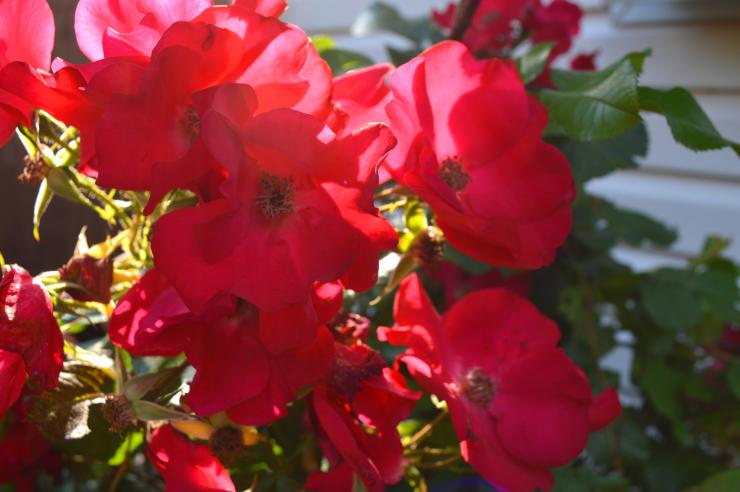

Photo: Robusta rose
Roses wintering without shelter
For cultivation in the conditions of the Moscow region, winter-hardy varieties are most suitable, which can not be covered before the beginning of winter. Non-covering rose varieties are easier to cultivate and require less maintenance. With the onset of spring, unpretentious winter-hardy roses bloom better and form more powerful plants.
Their flowering is long and abundant. The best roses, both beautiful and winter-hardy, can be found in all categories, be it David Austin roses, ground cover roses, climbing roses, Cordes roses, etc.
After planting, planting and caring for winter-hardy varieties are easier than those that freeze slightly without shelter. Shrub roses are not tall, even park roses or shrubs are higher than them. Climbing roses of constant flowering are preferred when grown in the Moscow region. Ground cover roses are well suited for different areas of the Moscow region.
Origin of ground cover
The progenitor of ground cover can be called the plant "Rosa Rugosa", wrinkled. The homeland of this plant is Japan, it is widespread in Korea and China. In the 20-30s of the XX century, as a result of crossing the variety "Rosa Rugosa" and other varieties, the first varieties appeared - "Max Graf" and "Fairy", which you can see in the photo, and only in the 60s were they bred another variety that has become no less popular is Nozomi.
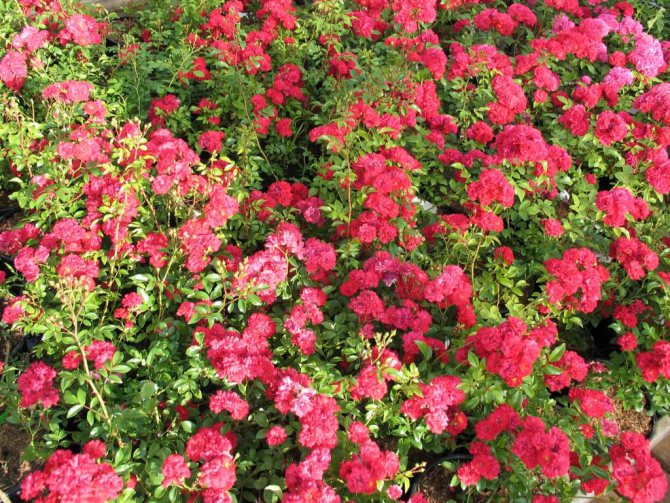

Roses "Fairy"
In the future, the selection continued more dynamically, now the assortment of varieties already numbers many dozen. Some of the most beautiful and best varieties are considered: "Mirato", "Diamant", "Hello", "Kent".
Five subgroups of ground cover varieties have now been identified:
- low with long shoots;
- low with creeping shoots;
- low strongly branching;
- wide with flowing whip-like shoots;
- wide upright.
Application in landscape design
Groundcover roses were bred to cover a large area with leafy and abundantly flowering shoots, giving the impression of a pink carpet. But the nature of their growth may be different. He defines the use of this group of roses in landscape design.
Sometimes highly expanding species are used as climbing ones, directing their growth upward. They become an adornment of pergolas, gazebos, hedges. Low-creeping varieties mask the defects of the site, decorate the slopes. With their help, soil erosion can be stopped. They will strengthen the soil on the slope and prevent it from being washed out during precipitation.
Groundcover roses will decorate any mixborder with annual and perennial flowers and evergreen shrubs. Groundcover rose borders accentuate the garden paths. With the help of tall varieties, they carry out zoning of the garden, create lush, brightly blooming hedges.
Hanging shoots of some varieties will decorate arches and fences. They are grown in vases and containers, which are then mobilely moved to the desired place. This group of roses is indispensable for the construction of rock gardens, rockeries, rocky gardens.
Distinctive features of the plant
Groundcover roses are a creeping plant with a spreading crown. Due to this feature, this culture is able to form a thick carpet of beautiful flowers of different colors on the site. In relation to the group of ground cover roses, several gradations are used, including the following:
- dwarf - bush height - up to 45 centimeters, width - 1.5 meters;
- low creeping - up to 50 centimeters and over 1.5 meters, respectively;
- undersized drooping - up to 0.4-0.6 meters and 1.5 meters;
- tall drooping - over 90 centimeters and 1.5 meters.
The first two varieties of roses, for several years after planting, form a dense carpet formed from many rooted shoots. Thanks to this feature, the culture is able to hide the flaws of the site.
If you take care of the plant correctly, then every year flowers with a diameter of 1-10 centimeters will appear on the bushes (depending on the variety). When choosing ground cover roses, you should take into account the peculiarities of the growth of the shrub. Some varieties are distinguished by shoots that bend into an arc as they develop.
Pruning
Experts recommend not pruning ground cover roses so as not to disturb their natural beauty. They are self-forming. The main thing is to plant them at such a distance that they do not interfere with each other when growing. And for the first-year girls, trim the ends of the shoots by cutting them slightly.
But it is still necessary to remove frozen, broken, diseased branches. This job is unpleasant. They are prickly. Some, pulling broken branches, put on welder's gloves. Although they are rough, they do not pierce with thorns.
Every 5-6 years, the bush is rejuvenated. To do this, it is strongly cut off, leaving 3-4 buds on the shoots.
Pruning ground cover roses in the garden
How to prune groundcover roses
Growing ground cover roses requires pruning. In the first years, the shoots of the plant are cut in the spring to stimulate growth and tillering. In subsequent years, in the spring, sanitary pruning of roses is arranged: weak, frozen, damaged shoots, as well as not fallen leaves, are removed. The twig is cut half a centimeter above the bud at a forty-five-degree angle.
Slices are processed with garden varnish. How often should you prune your roses? The rejuvenation of the bush is performed every five years, all branches are cut off, only 20 cm remains above the ground.

